Search Result
Results for "
peptide toxins
" in MedChemExpress (MCE) Product Catalog:
| Cat. No. |
Product Name |
Target |
Research Areas |
Chemical Structure |
-
- HY-P5917
-
|
Vaejovis mexicanus peptide 24
|
Potassium Channel
|
Others
|
|
Vm24-toxin is a toxin peptide that can be isolated from the Mexican scorpion Vaejovis mexicanus smithy. Vm24-toxin is an inhibitor of Kv1.3 potassium channel .
|
-

-
- HY-P5818
-
-

-
- HY-P1426
-
|
|
Potassium Channel
|
Inflammation/Immunology
|
|
AmmTX3 is a peptide toxin that can be isolated from the venom of the scorpion Androctonus mauretanicus. AmmTX3 is specific blocker of Kv4 channel. AmmTX3 inhibits the A-type K + current (Ki: 131 nM) .
|
-

-
- HY-P5801
-
|
μ-TrTx-Phlo1a
|
Sodium Channel
|
Neurological Disease
|
|
Phlo1a (μ-TrTx-Phlo1a) is a peptide toxin contains 35-amino acid residues. Phlo1b is a selective Nav1.7 inhibitor. Phlo1a has a weak inhibitory effect on Nav1.2 and Nav1.5 .
|
-

-
- HY-137788
-
|
|
nAChR
|
Neurological Disease
|
|
α-Conotoxin GI has high affinity for nAChR.α-Conotoxin GI is a short peptide toxin that can be isolated from the venom of Conus geographus.α-Conotoxin GI has the similar activity with neuromuscular blocking agent .
|
-

-
- HY-P5800
-
|
μ-TrTx-Phlo1b
|
Sodium Channel
|
Neurological Disease
|
|
Phlo1b (μ-TrTx-Phlo1b) is a peptide toxin contains 35-amino acid residues. Phlo1b is a selective Nav1.7 inhibitor. Phlo1b has a weak inhibitory effect on Nav1.2 and Nav1.5 .
|
-
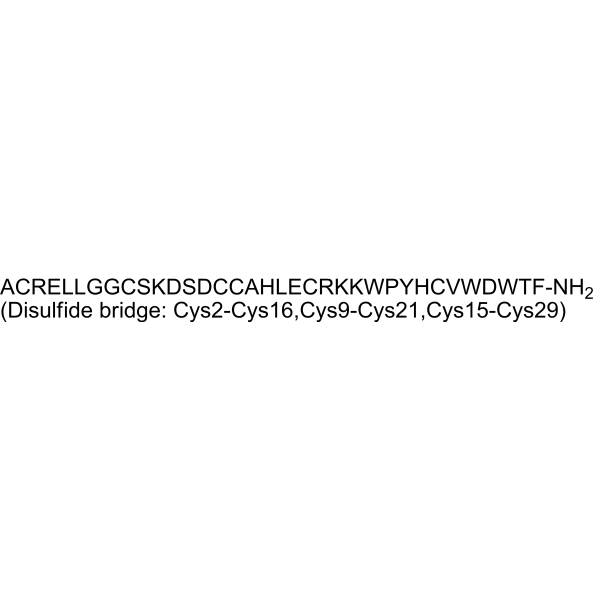
-
- HY-P5786
-
-

-
- HY-P5811
-
|
CcoTx1; β-TRTX-cm1a
|
Sodium Channel
|
Neurological Disease
|
|
Ceratotoxin-1 (CcoTx1), a peptide toxin, is an voltage-gated sodium channel subtypes inhibitor. Ceratotoxin-1 inhibits Nav1.1/β1, Nav1.2/β1, Nav1.4/β1, and Nav1.5/β1 with IC50 of 523 nM, 3 nM, 888 nM, and 323 nM, respectively. Ceratotoxin-1 also inhibits Nav1.8/β1 .
|
-

-
- HY-P1426A
-
|
|
Potassium Channel
|
Inflammation/Immunology
|
|
AmmTX3 TFA is a peptide toxin that can be isolated from the venom of the scorpion Androctonus mauretanicus. AmmTX3 TFA is specific blocker of Kv4 channel. AmmTX3 TFA inhibits the A-type K + current (Ki: 131 nM) .
|
-

-
- HY-P1280
-
|
|
Potassium Channel
|
Neurological Disease
|
|
Margatoxin, an alpha-KTx scorpion toxin, is a high affinity inhibitor of Kv1.3 (Kd=11.7 pM). Margatoxin inhibits the Kv1.2 (Kd=6.4 pM) and Kv1.1 (Kd=4.2 nM). Margatoxin, a 39 amino-acid-long peptide, is isolated from the venom of the scorpion Centruroides margaritatus and widely used in ion channel research .
|
-

-
- HY-P5164
-
|
|
Sodium Channel
|
Neurological Disease
|
|
GrTx1 is a peptide toxin originally isolated from the venom of the spider Grammostola rosea. GrTx1 blocks sodium channel, with IC50s of 0.63 µM, 0.23 µM, 0.77 µM, 1.29 µM, 0.63 µM and 0.37 µM for Nav1.1, Nav1.2, Nav1.3, Nav1.4, Nav1.6 and Nav1.7, repectively .GrTx1 can be used for neurological disease research .
|
-

-
- HY-P5175
-
|
|
mAChR
|
Neurological Disease
|
|
Muscarinic toxin 7 is a peptide toxin with selective and noncompetitive antagonism at the muscarinic M1 receptor .
|
-

-
- HY-P5942
-
-
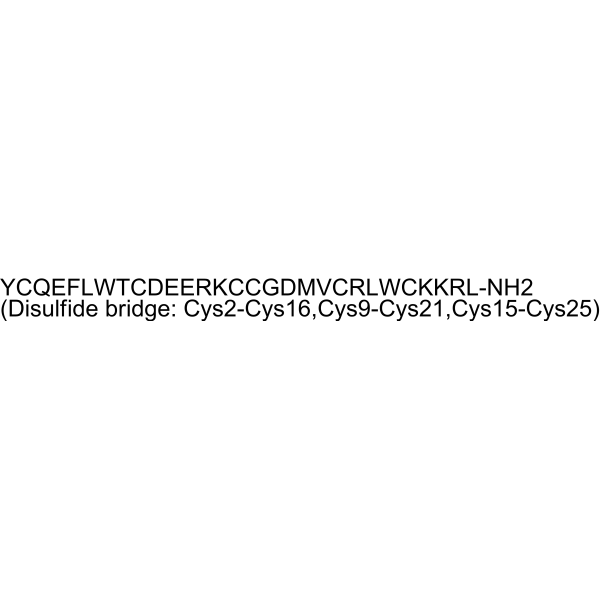
-
- HY-P5943
-
-

-
- HY-P5854
-
|
|
Potassium Channel
|
Neurological Disease
|
|
Aa1 toxin, a neurotoxic peptide that can be obtained from the venom of Androctonus australis Garzoni, is a specific potassium channel blocker. Aa1 toxin can be used in the study of neurological diseases .
|
-
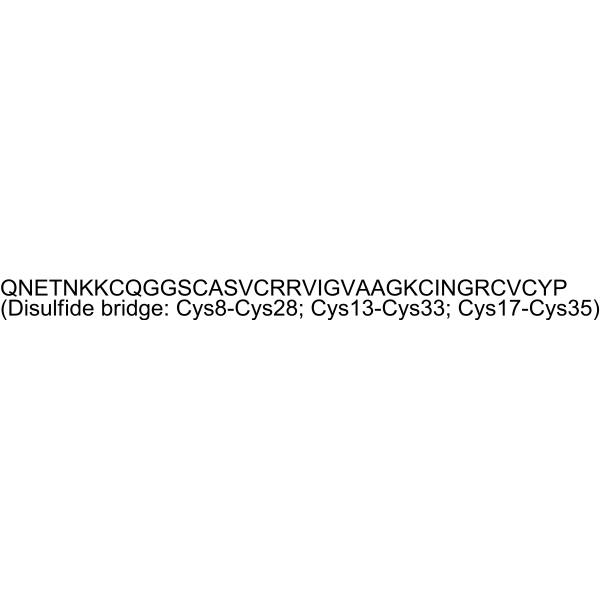
-
- HY-P10234
-
|
|
Sodium Channel
|
Others
|
|
Poneratoxin is a peptide toxin, which regulates the sodium currents in mammalian, and causes long-lasting pain .
|
-

-
- HY-125586
-
|
|
DNA/RNA Synthesis
ADC Cytotoxin
|
Cancer
|
|
β-Amanitin is a cyclic peptide toxin in the poisonous Amanita phalloides mushroom. β-Amanitin inhibits inhibits eukaryotic RNA polymerase II and III. β-Amanitin inhibits protein synthesis. β-Amanitin can be used as a cytotoxic component of antibody-drug conjugates (ADCs) .
|
-
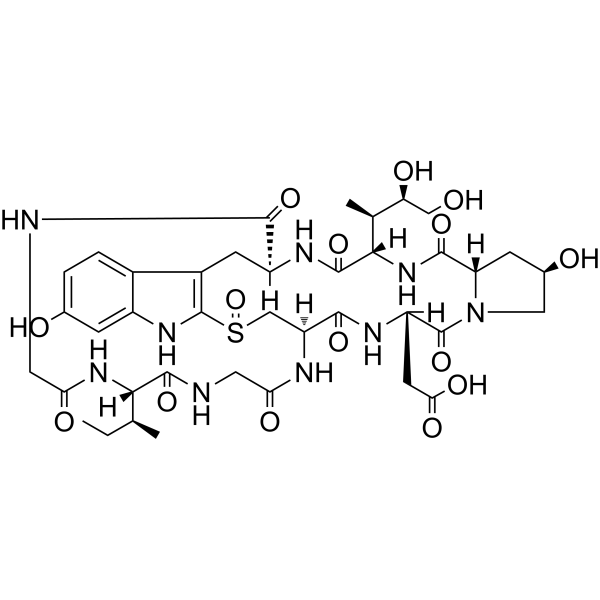
-
- HY-P5177
-
-

-
- HY-P5140
-
|
|
Calcium Channel
|
Metabolic Disease
|
|
ω-Tbo-IT1 is a peptide toxin that can be isolated from the venom of Tibellus oblongus.ω-Tbo-IT1 is an inhibitor of insect calcium channel .
|
-

-
- HY-P3037
-
|
|
Calcium Channel
|
|
|
Imperatoxin A, a peptide toxin derived from the venom of the African scorpion Pandinus imperator, activator of Ca 2+-release channels/ryanodine receptors (RyRs)? enhances the influx of Ca 2+ from the sarcoplasmatic reticulum into the cell .
|
-

-
- HY-P5162
-
|
|
Sodium Channel
|
Inflammation/Immunology
|
|
Dc1a potently promotes opening of the German cockroach Nav channel (BgNav1). Dc1a is a toxin can be isolated from the desert bush spider Diguetia canities .
|
-

-
- HY-P5798
-
|
FAS-I
|
Cholinesterase (ChE)
|
Neurological Disease
|
|
Fasciculin-I is isolated from the mambas venom. Fasciculin-I exerts its toxic effects by inhibiting acetylcholinesterase (AChE). Fasciculin-I blocks α-neurotoxins of nicotinic acetylcholine receptors and cardiac toxins that interact with cell membranes .
|
-

-
- HY-P5179
-
|
HWTX-I
|
Calcium Channel
Sodium Channel
|
Neurological Disease
|
|
Huwentoxin I (HWTX-I) is a peptide toxin that inhibits voltage-gated sodium channels and N-type calcium channels. Huwentoxin I inhibits sodium channels in rat hippocampus and cockroach dorsal unpaired median (DUM) neurons with IC50 values of 66.1 and 4.80 nM, respectively .
|
-

-
- HY-P5852
-
|
Alpha-conotoxin EIIB
|
nAChR
|
Neurological Disease
|
|
α-Conotoxin EIIB (Alpha-conotoxin EIIB) is a toxin peptide that can be obtained from Conus ermineus. α-Conotoxin EIIB binds to nAChR (Ki=2.2 nM). α-Conotoxin EIIB can be used in the study of neurological diseases such as schizophrenia, drug addiction, Alzheimer's disease, and Parkinson's disease .
|
-
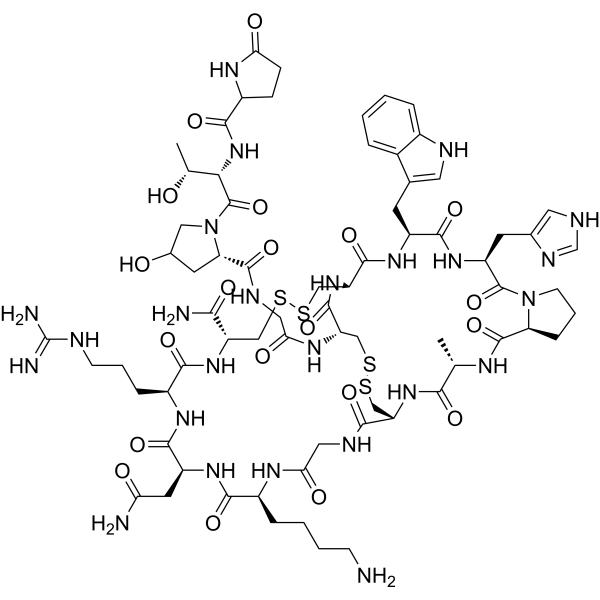
-
- HY-P5153
-
|
μ-TRTX-Tp1a
|
Sodium Channel
|
Neurological Disease
|
|
ProTx-III is a selective and potent inhibitor of voltage-gated sodium channel Nav1.7, with an IC50 of 2.1 nM. ProTx-III is a spider venom peptide isolated from the venom of the Peruvian green velvet tarantella. ProTx-III has a typical inhibitor cystine knot motif (ICK). ProTx-III is able to reverse the pain response. ProTx-III can be used to study diseases such as chronic pain, epilepsy, and arrhythmia .
|
-

-
- HY-P1280A
-
|
|
Potassium Channel
|
Neurological Disease
|
|
Margatoxin TFA, an alpha-KTx scorpion toxin, is a high affinity inhibitor of Kv1.3 (Kd=11.7 pM). Margatoxin TFA inhibits the Kv1.2 (Kd=6.4 pM) and Kv1.1 (Kd=4.2 nM). Margatoxin TFA, a 39 amino-acid-long peptide, is isolated from the venom of the scorpion Centruroides margaritatus and widely used in ion channel research .
|
-

-
- HY-P5165
-
|
|
Potassium Channel
|
Inflammation/Immunology
|
|
Maurotoxin is a 34-residue and four disulde-bridged toxin that can be isolated from the chactoid scorpion (Scorpio maurus). Maurotoxin inhibits the Shaker potassium channels (ShB) K + current with an IC50 of 2 nM .
|
-
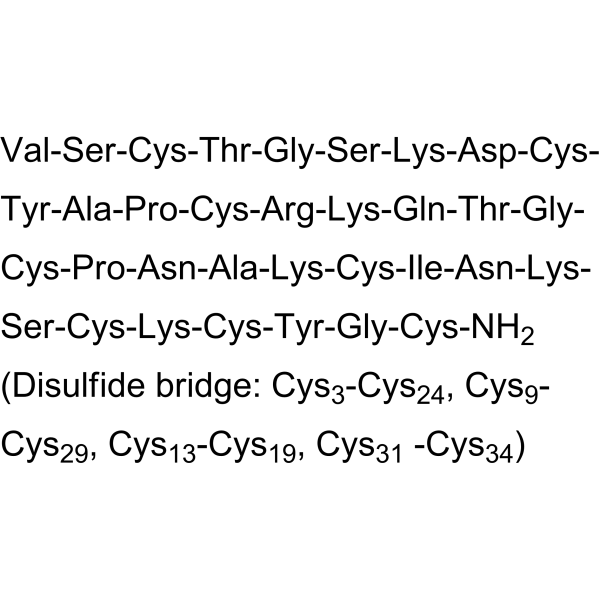
-
- HY-P5156
-
|
|
Potassium Channel
|
Neurological Disease
|
|
BDS-I known as blood depressing substance, is a marine toxin which can be extracted from Anemonia sulcata. BDS-I is a specific inhibitor of Potassium Channel, targeting to Kv3.4. BDS-I inhibits Aβ1-42-induced enhancement of KV3.4 activity, caspase-3 activation, and abnormal nuclear morphology of NGF-differentiated PC-12 cells. BDS-I reverts the Aβ peptide-induced cell death .
|
-

-
- HY-P5807A
-
|
β-Mammal toxin Cn2 TFA
|
Sodium Channel
|
Neurological Disease
|
|
Cn2 toxin TFA (β-Mammal toxin Cn2 TFA) is a single-chain β-scorpion neurotoxic peptide that is the main toxin in scorpion venom. Cn2 toxin (TFA) specifically targets mammalian voltage-gated sodium channels (VGSC) Nav1.6 .
|
-

-
- HY-P4211
-
|
|
Bacterial
|
Infection
|
|
PSM-β is a active peptide , which can be isolated from Staphylococcus epidermidis. PSM-β is an analog of staphylococcal toxins, as well as a termed phenol-soluble modulin. PSM-β has bacteriostatic and poorly hemolytic properties .
|
-
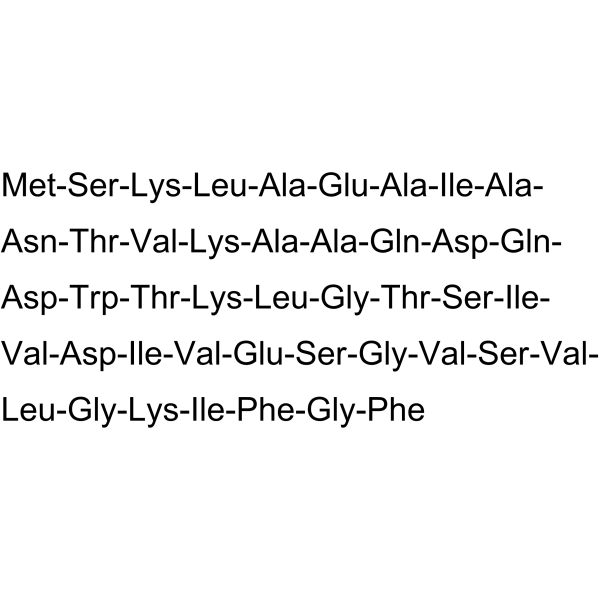
-
- HY-P3064
-
|
Leiurotoxin I
|
Potassium Channel
|
Neurological Disease
|
|
Scyllatoxin (Leiurotoxin I) is a peptide toxin, it can be isolated from the venom of the scorpion (Leiurus quinquestriatus hebraeus). Scyllatoxin is a blocker of small-conductance KCa (SK) channel. Scyllatoxin enhances both norepinephrine (NE) and epinephrine (Epi) release in vivo .
|
-
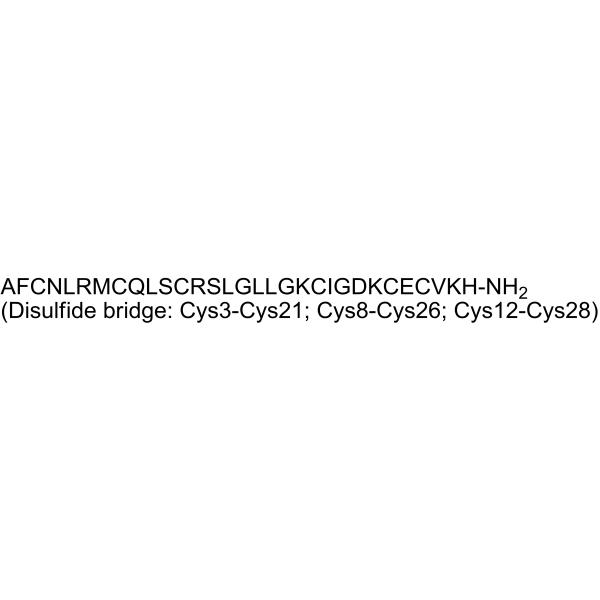
-
- HY-E70128
-
|
|
Others
|
Others
|
|
Leucyl aminopeptidase is a metallopeptidase that cleave N-terminal residues from proteins and peptides. Leucyl aminopeptidase serves as transcriptional repressors to control pyrimidine, alginate and cholera toxin biosynthesis, as well as mediate site-specific recombination events in plasmids and phages .
|
-

-
- HY-P1105
-
|
|
Chloride Channel
|
Neurological Disease
|
|
GaTx2 is a seletive and a high affinity inhibitor of ClC-2 channels with a voltage-dependent apparent KD of ∼20 pM. GaTx2 is a peptide toxin inhibitor from Leiurus quinquestriatus hebraeus venom. GaTx2 is useful in determining the role and the membrane localization of ClC-2 in specific cell types .
|
-

-
- HY-P5182A
-
|
|
Potassium Channel
|
Inflammation/Immunology
|
|
HsTX1 (TFA) toxin, from the scorpion Heterometrus spinnifer, is a 34-residue, C-terminally amidated peptide cross-linked by four disulfide bridges. HsTX1 (TFA) is an the inhibitor of potassium channel, with IC50 for Kv1.3 of 12 pM and inhibits TEM cell activation and attenuates inflammation in autoimmunity .
|
-

-
- HY-138298A
-
|
DS-8201; DS-8201a
|
Antibody-Drug Conjugates (ADCs)
EGFR
|
Cancer
|
|
Trastuzumab deruxtecan (DS-8201a) is an anti-human epidermal growth factor receptor 2 (HER2) antibody-drug conjugate (ADC). Trastuzumab deruxtecan is composed of a humanized anti-HER2 antibody, an enzymatically cleavable peptide-linker, a topoisomerase I inhibitor (a toxin component of Dxd). Trastuzumab deruxtecan can be used for the research of HER2-positive breast cancer and gastric cancer .
|
-

-
- HY-P2358
-
|
|
Toll-like Receptor (TLR)
|
Inflammation/Immunology
|
|
PSMα3 is a peptide for manipulating DCs to become tolerogenic for DC vaccination strategies. PSMα3 penetrates and modulates human monocyte-derived DCs by altering the TLR2- or TLR4-induced maturation, inhibiting pro- and anti-inflammatory cytokine production and reducing antigen uptake. PSMα3 is an important toxin released by the most virulent strains of methicillin-resistant Staphylococcus aureus (MRSA) .
|
-

-
- HY-138298
-
|
DS-8201 (solution); DS-8201a (solution)
|
Antibody-Drug Conjugates (ADCs)
EGFR
|
Cancer
|
|
Trastuzumab deruxtecan (T-DXd; DS-8201a) (solution) is an anti-human epidermal growth factor receptor 2 (HER2) antibody-drug conjugate (ADC). Trastuzumab deruxtecan is composed of a humanized anti-HER2 antibody, an enzymatically cleavable peptide-linker, a topoisomerase I inhibitor (a toxin component of Dxd). Trastuzumab deruxtecan can be used for the research of HER2-positive breast cancer and gastric cancer .
|
-

-
- HY-P3444
-
|
PECAM-1
|
SHP2
Bacterial
|
Metabolic Disease
Inflammation/Immunology
|
|
CD31 (PECAM-1) is platelet endothelial cell adhesion molecule-1, serves as the endothelial cell-specific receptor of clostridium perfringens b-Toxin (CPB). CD31 is also an ER-MP12 antigen, acts as a linker between mechanical stress, metabolism and inflammation. CD31 peptide is able to sustain phosphorylation of the CD31 ITIM686 and of SHP2 and to inhibit TCR-induced T-cell activation - .
|
-

-
- HY-P3444A
-
|
PECAM-1 TFA
|
SHP2
Bacterial
|
Metabolic Disease
Inflammation/Immunology
|
|
CD31 (PECAM-1) TFA is platelet endothelial cell adhesion molecule-1, serves as the endothelial cell-specific receptor of clostridium perfringens b-Toxin (CPB). CD31 TFA is also an ER-MP12 antigen, acts as a linker between mechanical stress, metabolism and inflammation. CD31 TFA peptide is able to sustain phosphorylation of the CD31 ITIM686 and of SHP2 and to inhibit TCR-induced T-cell activation - .
|
-

-
- HY-400684
-
|
|
Others
|
Cancer
|
|
Tubulysin A intermediate-1 is an intermediate in the synthesis of the cytotoxic peptide Tubulysin A (HY-15995). Tubulysin A (TubA) is an antibiotic, anti-microtubule toxins, and apoptosis inducer isolated from myxobacteria. Tubulysin A has anti-angiogenic, anti-microtubule, anti-mitotic, and anti-proliferative activities. Tubulysin A arrests cells in the G2/M phase, effectively inhibits tubulin polymerization, and induces depolymerization of detached microtubules. Tubulysin A acts as an ADC cytotoxin (ADC Cytotoxin) to synthesize ADC .
|
-
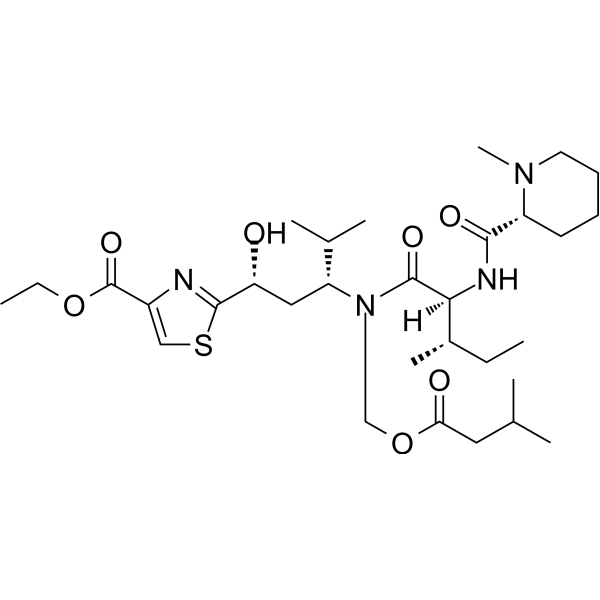
-
- HY-P1117
-
|
|
Formyl Peptide Receptor (FPR)
Calcium Channel
|
Neurological Disease
Inflammation/Immunology
|
|
MMK1 is a potent and selective human formyl peptide receptor like-1 (FPRL-1/FPR2) agonist with EC50s of <2 nM and >10000 nM for FPRL-1 and FPR1, respectively. MMK1 is a potent chemotactic and calcium-mobilizing agonist. MMK1 potently activates phagocytic leukocytes and enhances Pertussis Toxin (HY-112779)-sensitive production by human monocytes of proinflammatory cytokines IL-1b and IL-6. MMK1 exerts anxiolytic-like activity .
|
-

-
- HY-P1117A
-
|
|
Formyl Peptide Receptor (FPR)
Calcium Channel
|
Neurological Disease
Inflammation/Immunology
|
|
MMK1 TFA is a potent and selective human formyl peptide receptor like-1 (FPRL-1/FPR2) agonist with EC50s of <2 nM and >10000 nM for FPRL-1 and FPR1, respectively. MMK1 TFA is a potent chemotactic and calcium-mobilizing agonist. MMK1 TFA potently activates phagocytic leukocytes and enhances Pertussis Toxin (HY-112779)-sensitive production by human monocytes of proinflammatory cytokines IL-1b and IL-6. MMK1 TFA exerts anxiolytic-like activity .
|
-
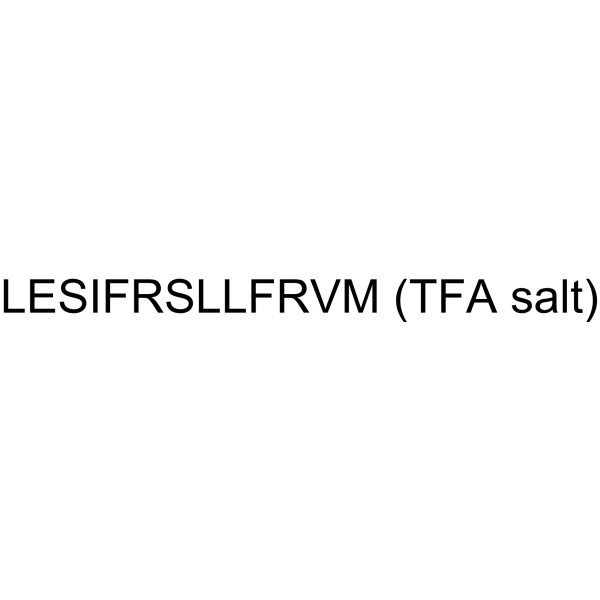
-
- HY-P0256
-
Apamin
3 Publications Verification
Apamine
|
Potassium Channel
|
Neurological Disease
Inflammation/Immunology
|
|
Apamin (Apamine) is an 18 amino acid peptide neurotoxin found in apitoxin (bee venom), is known as a specifically selective blocker of Ca 2+-activated K + (SK) channels and exhibits anti-inflammatory and anti-fibrotic activity .
|
-
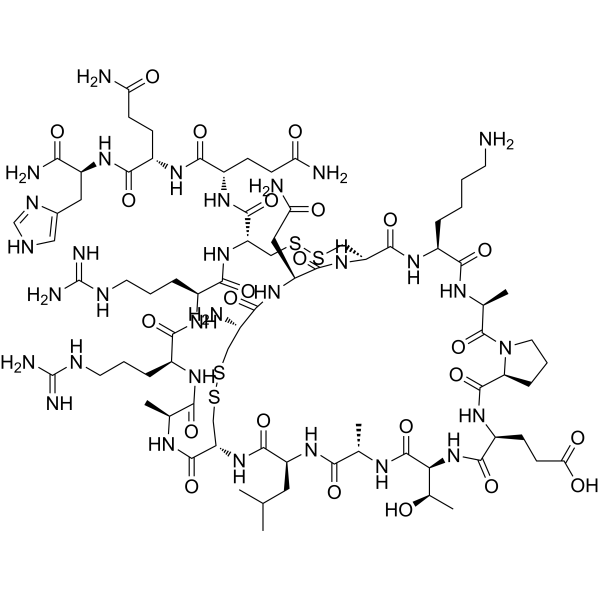
-
- HY-P0173A
-
|
|
Chloride Channel
|
Cancer
|
|
Chlorotoxin is a 36 amino-acid peptide from the venom of the Israeli scorpion Leiurus quinquestriatus with anticancer activity. Chlorotoxin is a chloride channel blocker.
|
-

-
- HY-P1411
-
|
PcTx1; Psalmopoeus cambridgei toxin-1
|
Sodium Channel
Apoptosis
|
Neurological Disease
Cancer
|
|
Psalmotoxin 1 (PcTx1) is a protein toxin that can bind at subunit-subunit interfaces of acid-sensing ion channel 1a (ASIC1a). Psalmotoxin 1 is a potent and slective ASIC1a inhibitor (IC50: 0.9 nM) by increasing the apparent affinity for H + of ASIC1a. Psalmotoxin 1 can induce cell apoptosis, also inhibits cell migration, proferliration and invasion of cancer cells. Psalmotoxin 1 can be used in the research of cancers, or neurological disease .
|
-

-
- HY-P0173B
-
|
|
Chloride Channel
|
Cancer
|
|
Chlorotoxin TFA is a peptide isolated from the venom of the scorpion Leiurus quinquestriatus, acts as a chloride channel blocker . Anti-cancer activity .
|
-
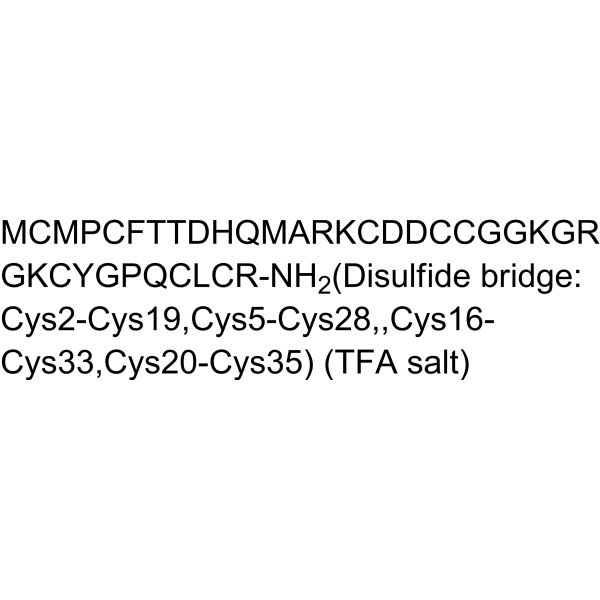
-
- HY-P1410A
-
GsMTx4 TFA
Maximum Cited Publications
28 Publications Verification
|
TRP Channel
Piezo Channel
|
Cardiovascular Disease
Neurological Disease
Inflammation/Immunology
|
|
GsMTx4 TFA is a spider venom peptide that selectively inhibits cationic-permeable mechanosensitive channels (MSCs) belonging to the Piezo and TRP channel families. GsMTx4 TFA also blocks cation-selective stretch-activated channels (SACs) , attenuates lysophosphatidylcholine (LPC)-induced astrocyte toxicity and microglial reactivity. GsMTx4 TFA is an important pharmacological tool for identifying the role of these excitatory MSCs in normal physiology and pathology .
|
-
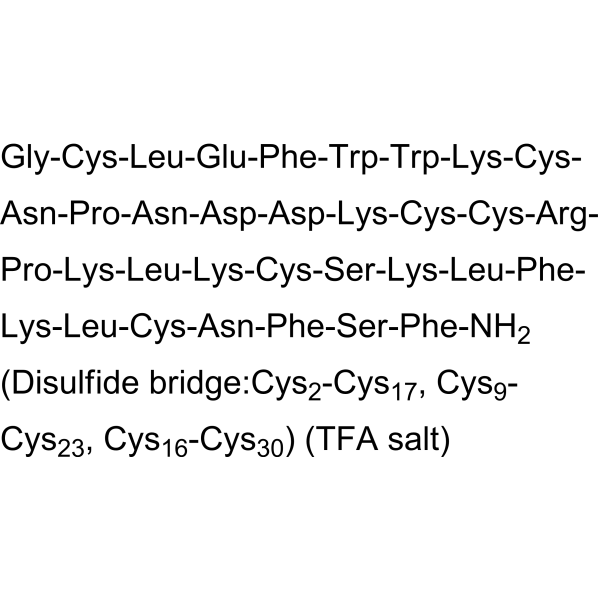
-
- HY-P1268A
-
|
|
nAChR
|
Neurological Disease
|
|
α-Conotoxin PIA TFA is a nicotinic acetylcholine receptor (nAChR) antagonist that targets nAChR subtypes containing α6 and α3 subunits. α-Conotoxin PIA has the potential for the research of Parkinson’s disease, and schizophrenia 。
|
-
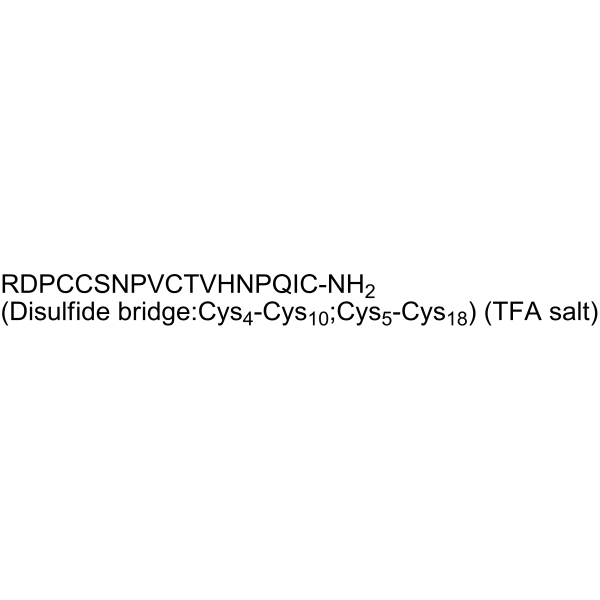
-
- HY-P1346
-
|
|
Sodium Channel
|
Neurological Disease
Inflammation/Immunology
|
|
APETx2, a sea anemone peptide from Anthopleura elegantissima, is a selective and reversible ASIC3 inhibitor, with an IC50 of 63 nM. APETx2 directly inhibits the ASIC3 channel by acting at its external side. APETx2 could reverses acid‐induced and inflammatory pain .
|
-

-
- HY-P0189A
-
-

- HY-P1078
-
|
|
Calcium Channel
|
Neurological Disease
|
|
Huwentoxin XVI, an analgesic, is a highly reversible and selective mammalian N-type calcium channel (IC50 of ~60 nM) antagonist from Chinese tarantula Ornithoctonus huwena. Huwentoxin XVI has no effect on voltagegated T-type calcium channels, potassium channels or sodium channels .
|
-
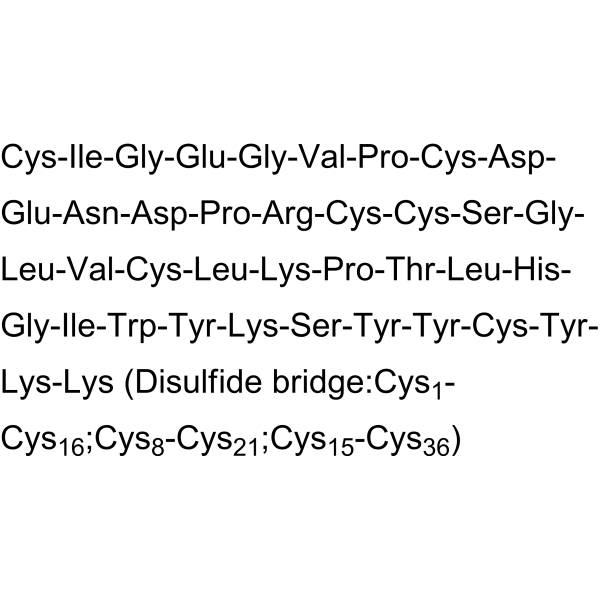
- HY-P1189
-
|
|
Integrin
|
Metabolic Disease
Inflammation/Immunology
|
|
Echistatin, the smallest active RGD protein belonging to the family of disintegrins that are derived from snake venoms, is a potent inhibitor of platelet aggregation. Echistatin is a potent inhibitor of bone resorption in culture. Echistatin is a potent antagonist of αIIbβ3, αvβ3 and α5β1 .
|
-
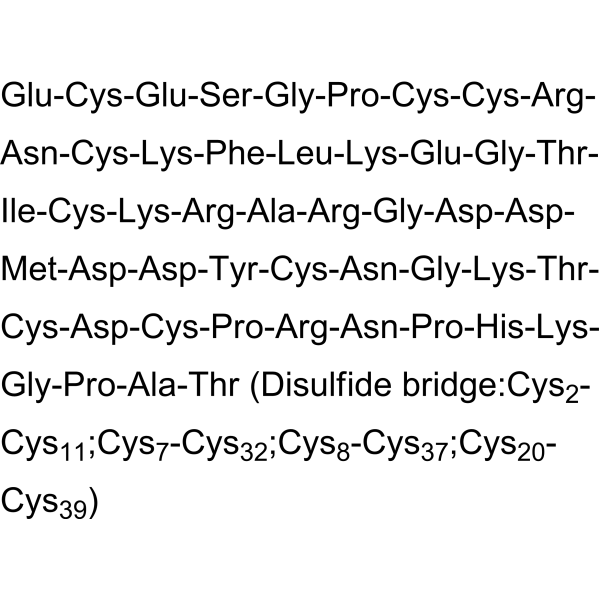
- HY-P1293
-
|
|
iGluR
|
Neurological Disease
|
|
Conantokin G, a 17-amino-acid peptide, is a potent, selective and competitive antagonist of N-methyl-D-aspartate (NMDA) receptors. Conantokin G inhibits NMDA-evoked currents in murine cortical neurons with an IC50 of 480 nM. Conantokin G has neuroprotective properties .
|
-
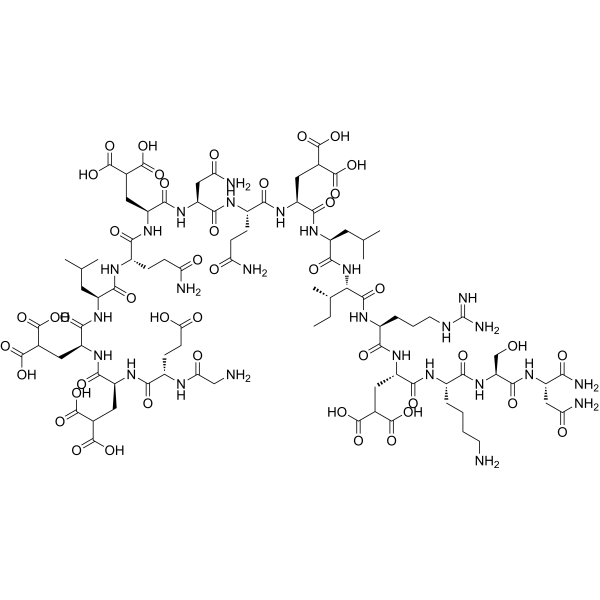
- HY-P1282
-
-
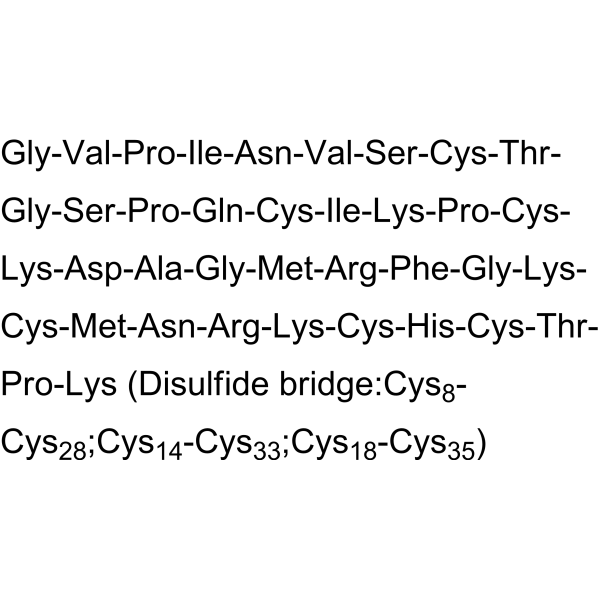
- HY-P1220A
-
|
|
Sodium Channel
|
Neurological Disease
|
|
Huwentoxin-IV TFA is a potent and selective sodium channel blocker, inhibits neuronal Nav1.7, Nav1.2, Nav1.3 and Nav1.4 with IC50s of 26, 150, 338 and 400 nM, respectively. Huwentoxin-IV TFA preferentially blocks peripheral nerve subtype Nav1.7 by binding neurotoxin receptor site 4. Huwentoxin-IV TFA has analgesic effects on animal models of inflammatory and neuropathic pain .
|
-

- HY-P1441
-
|
|
Sodium Channel
|
Others
|
|
Mambalgin-1 is a toxin isolated from black mamba venom. Mambalgin-1 is a disulfide-rich polypeptide consisting of 57 amino acids and belongs to the family of three-finger toxins. Mambalgin-1 can bind to and stabilize ASICs (acid-sensing ion channels) in a physiologically relevant closed-channel conformation .
|
-
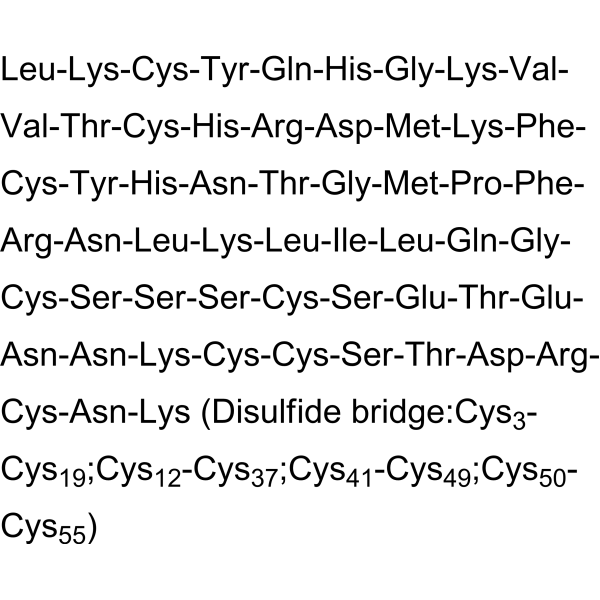
- HY-P1424
-
|
|
Potassium Channel
|
Neurological Disease
|
|
Lei-Dab7 is a potent and selective SK2 (KCa2.2) channels blocker with a Kd of 3.8 nM. Lei-Dab7 shows low or no activity on KCa1, KCa3, Kv and Kir2.1 channels .
|
-
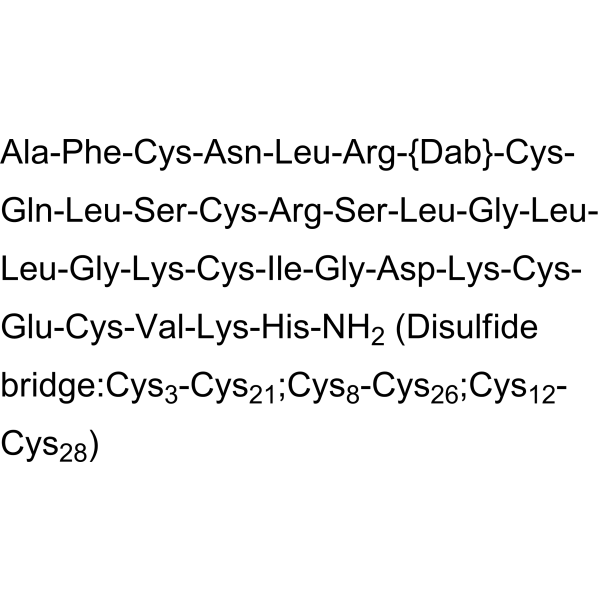
- HY-P1410
-
GsMTx4
Maximum Cited Publications
28 Publications Verification
|
TRP Channel
Piezo Channel
|
Cardiovascular Disease
Neurological Disease
Inflammation/Immunology
|
|
GsMTx4 is a spider venom peptide that selectively inhibits cationic-permeable mechanosensitive channels (MSCs) belonging to the Piezo and TRP channel families. GsMTx4 also blocks cation-selective stretch-activated channels (SACs) , attenuates lysophosphatidylcholine (LPC)-induced astrocyte toxicity and microglial reactivity. GsMTx4 is an important pharmacological tool for identifying the role of these excitatory MSCs in normal physiology and pathology .
|
-
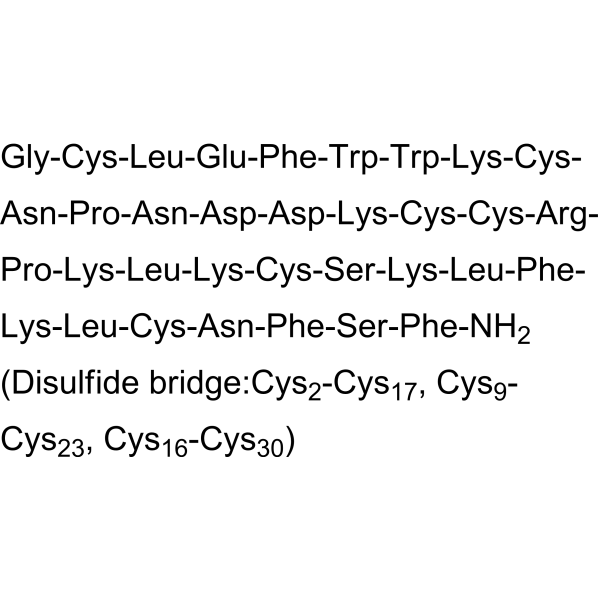
- HY-P1440
-
-
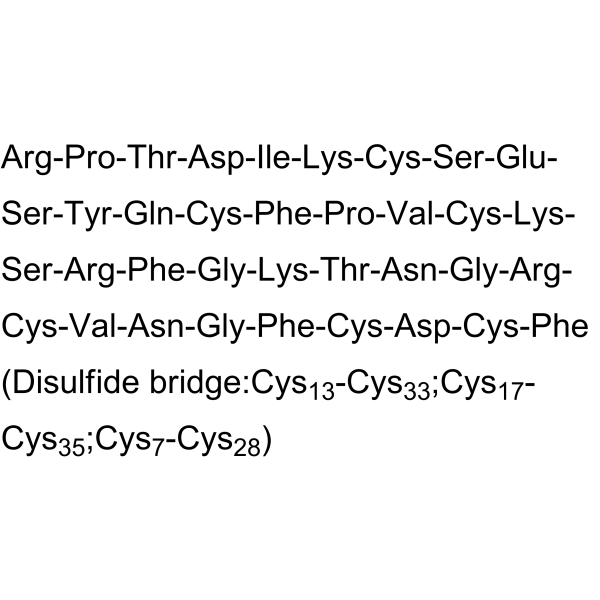
- HY-P1221
-
|
|
Sodium Channel
|
Neurological Disease
|
|
ProTx II is a selective blocker of Nav1.7 sodium channels with an IC50 of 0.3 nM, and is at least 100-fold selective for Nav1.7 over other sodium channel subtypes. ProTx-II inhibits sodium channels by decreasing channel conductance and shifting activation to more positive potentials and blocks action potential propagation in nociceptors .
|
-

- HY-P1701
-
|
|
Opioid Receptor
|
Cardiovascular Disease
Neurological Disease
|
|
Morphiceptin is a potent and specific agonist for morphine (μ) receptors. Morphiceptin, as a synthetic peptide, is the amide of a fragment of the milk protein β-casein. Morphiceptin has morphinelike activities and is highly specific for morphine (μ) receptors but not for enkephalin (⸹) receptors .
|
-
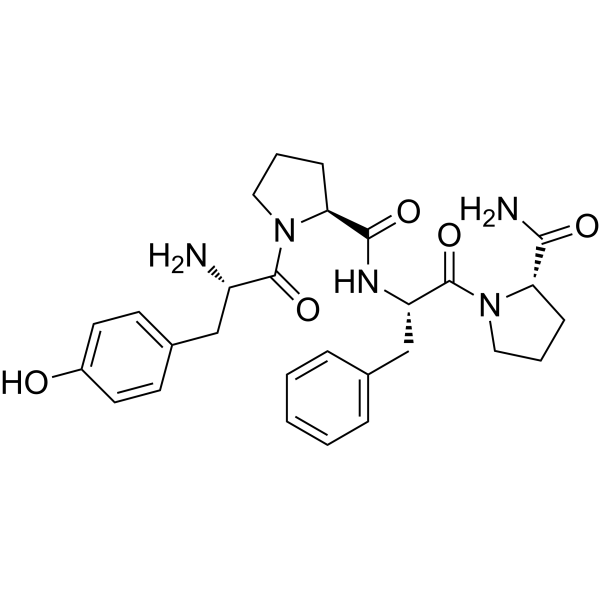
- HY-P1427
-
|
|
Potassium Channel
|
Neurological Disease
|
|
Guangxitoxin 1E is a potent and selective blocker of KV2.1 and KV2.2 channels. Guangxitoxin 1E inhibits KV2 with an IC50 of 1-3 nM. KV2 channels underlie delayed-rectifier potassium currents in various neurons .
|
-
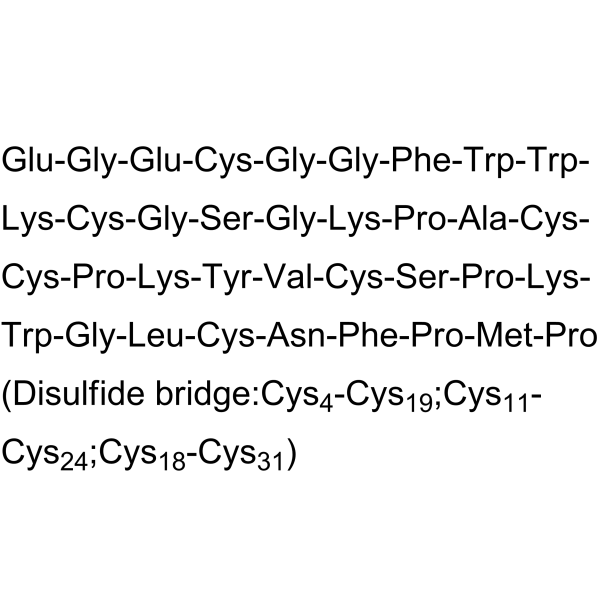
- HY-P1219
-
|
β-TRTX-Cj1α
|
Sodium Channel
|
Neurological Disease
|
|
Jingzhaotoxin-III is a potent and selective blocker of Nav1.5 channels, with an IC50 of 348 nM, and shows no effect on other sodium channel isoforms. Jingzhaotoxin-III can selectively inhibit the activation of cardiac sodium channel but not neuronal subtypes, and hopefully represents an important ligand for discriminating cardiac VGSC subtype .
|
-

- HY-P1409
-
|
|
Potassium Channel
|
Inflammation/Immunology
|
|
ADWX 1 is a new peptide inhibitor that is potent and selective for Kv1.3 with an IC50 value of 1.89 pM. ADWX 1 inhibits Kv1.3 channel activity specifically to inhibit both the initial calcium signaling and NF-κB activation. ADWX 1 ameliorates the disease in rats of experimental autoimmune encephalomyelitis (EAE) models. ADWX 1 can be used to study T cell-mediated autoimmune diseases .
|
-

- HY-P5158
-
|
|
Adrenergic Receptor
|
Others
|
|
Conopeptide rho-TIA is a peptide derived from the venom contained in the predatory sea snail Conus tulipa, has highly selective and noncompetitive inhibitor at human α1B-Adrenergic Receptor. Conopeptide rho-TIA acts a competitive inhibitor at human α1A-Adrenergic Receptor and α1D-Adrenergic Receptor. Conopeptide rho-TIA binds to each subtype and may provide useful information for the development of novel α1-Adrenergic Receptor subtype-selective drugs .
|
-
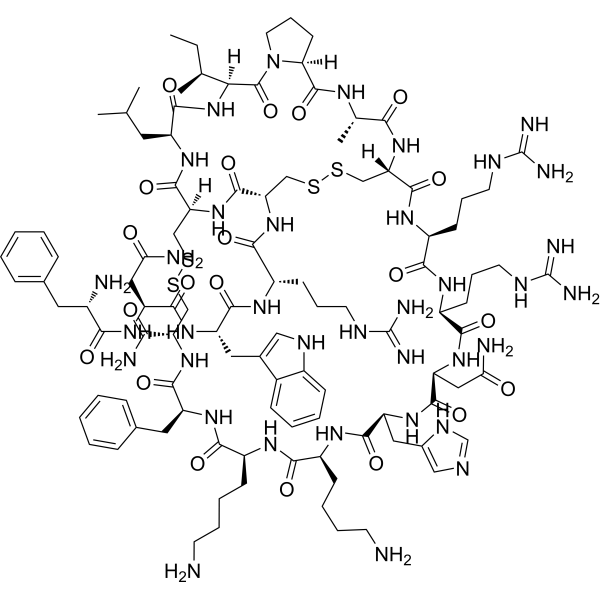
- HY-P1330
-
|
|
P2X Receptor
|
Inflammation/Immunology
|
|
Purotoxin 1 is a P2X3 receptor inhibitor. Purotoxin 1 shows antinociceptive properties in animal models of inflammatory pain. Purotoxin 1 can be isolated from the venom of the wolf spider Geolycosa sp .
|
-
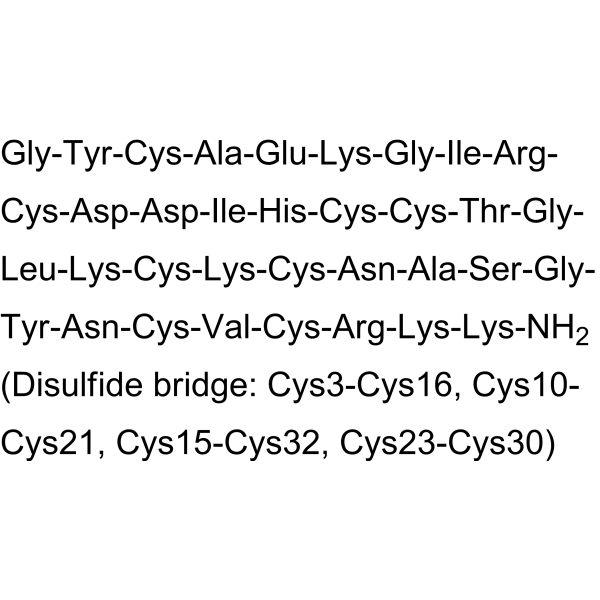
- HY-P1408
-
|
|
Integrin
|
Cancer
|
|
Obtustatin is a non-RGD disintegrin of 41 residues. Obtustatin can be isolated from Vipera lebetina obtusa venom. Obtustatin is a potent and selective inhibitor of the adhesion of integrin α1β1 to collagen IV. Obtustatin inhibits angiogenesis, and can be used for research of cancer .
|
-

- HY-P1442
-
|
|
Adrenergic Receptor
|
Cancer
|
|
AdTx1 is a selective α1A-adrenoceptor antagonist (Ki: 0.35 nM). AdTx1 can be used for research of benign prostatic hyperplasia .
|
-

- HY-P1443
-
|
|
Sodium Channel
|
Cancer
|
|
OD1 is a scorpion α-toxin that can be isolated from the venom of the Iranian yellow scorpion (Odonthobuthus doriae. OD1 is a modulator of mammalian Nav1.7 (EC50: 4.5 nM) .
|
-
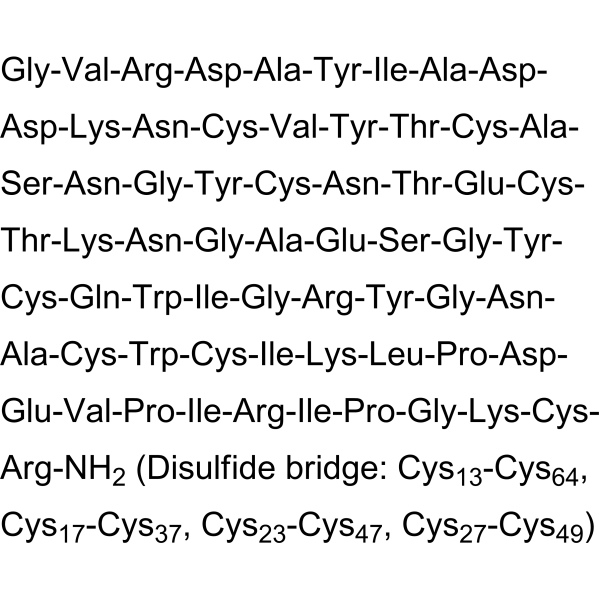
- HY-P1604
-
|
|
Sodium Channel
|
Inflammation/Immunology
|
|
ATX-II is a specific Na + channel Modulator toxin that can be isolated from the venom of sea anemone (Anemonia sulcata). ATX-II causes delayed inactivation of the Na +
|
-

- HY-P1952
-
|
|
Sodium Channel
|
Inflammation/Immunology
|
|
μ-Conotoxin-CnIIIC is a 22-residue conopeptide that can be isolated from Conus consors. μ-Conotoxin-CnIIIC is a potent and persistent blocker of NaV1.4 channel. μ-Conotoxin-CnIIIC has analgesic, anaesthetic and myorelaxant properties .
|
-

- HY-P2700
-
|
|
Sodium Channel
|
Neurological Disease
|
|
μ-Conotoxin GIIIB is a 22-residue polypeptide that can be isolated from the venom of piscivorous cone snail Conus geographus. μ-Conotoxin GIIIB is a NaV1.4 channel inhibitor. μ-Conotoxin GIIIB blocks muscle cell's contraction .
|
-
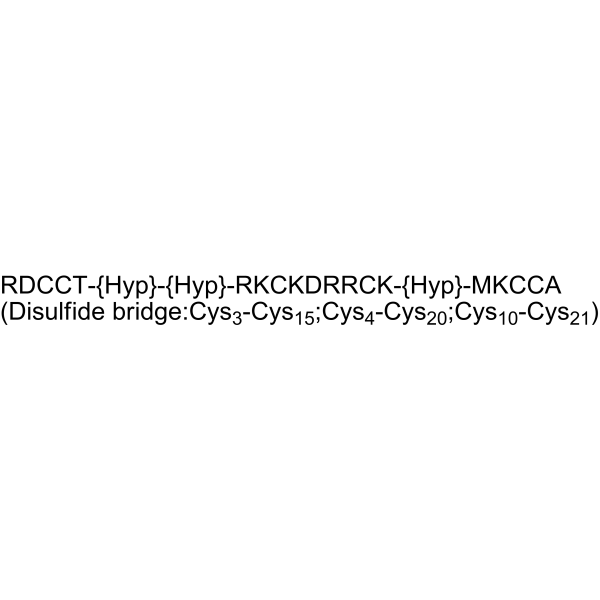
- HY-P3071
-
|
|
Potassium Channel
|
Inflammation/Immunology
|
|
ShK toxin blocks voltage-dependent potassium channel (Kv1.3 channel). ShK toxin can be isolated from the whole body extract of the Caribbean sea anemone (Stichodactylu helianthus). ShK toxin competes with dendrotoxin I and α-dendrotoxin for binding to synaptosomal membranes of rat brain, facilitates acetylcholine release. ShK toxin suppresses K+ currents in cultured rat dorsal root ganglion neurons. ShK toxin also inhibits T lymphocyte proliferation .
|
-

- HY-P5142
-
|
ω-ACTX-Hv1; ω-Atracotoxin-HV1
|
Calcium Channel
|
Neurological Disease
|
|
ω-Hexatoxin-Hv1a is a neurotoxin that can be isolated from the venom spider (Hadronyche versuta).ω-Hexatoxin-Hv1a blocks voltage-gated calcium channels .
|
-
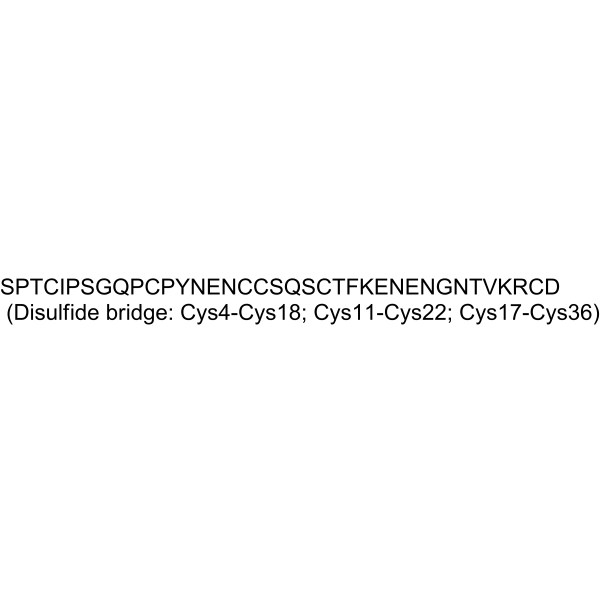
- HY-P5159
-
|
|
Sodium Channel
|
Inflammation/Immunology
|
|
Crotamine is a Na + channel modulator. Crotamine is a 42 amino acid toxin cross-linked by three disulfide bridges. Crotamine has analgesic activity. Crotamine also interacts with lipid membranes and shows myonecrotic activity. Crotamine can be isolated from Crotalus durissus terrificus venom .
|
-

- HY-P5146
-
-
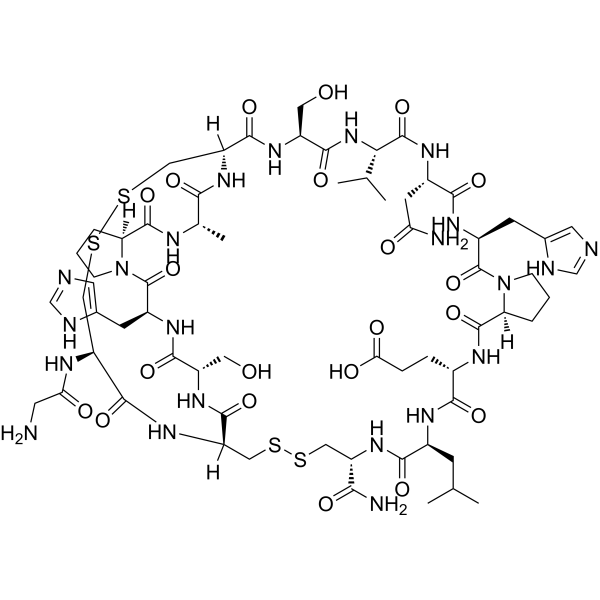
- HY-P5141
-
|
|
Sodium Channel
|
Inflammation/Immunology
|
|
μ-Conotoxin KIIIA is an analgesic μ-conotoxin that can be isolated from Conus kinoshitai. μ-Conotoxin KIIIA blocks mammalian neuronal voltage-gated sodium channels (VGSCs) (Nav1.2).μ-Conotoxin KIIIA can be used for research of pain .
|
-
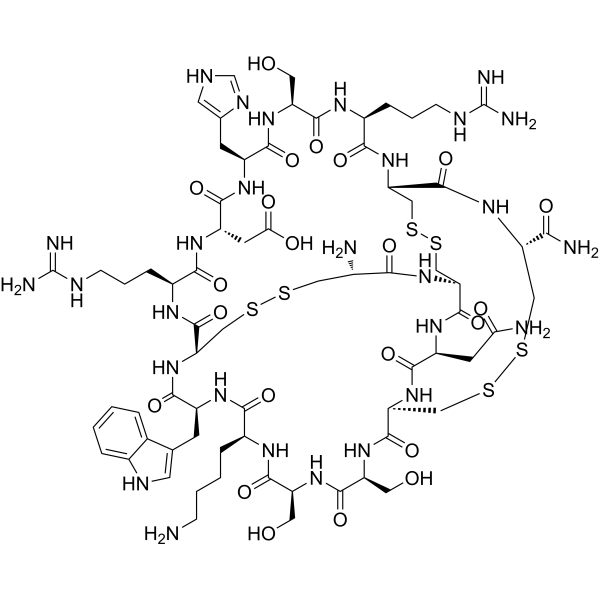
- HY-P5143
-
|
|
Calcium Channel
|
Inflammation/Immunology
|
|
ω-Conotoxin SO3 is a blocker of N-type voltage-sensitive calcium channel. ω-Conotoxin SO3 is an analgesicω-conotoxin that can be isolated from the venom of C. striatus .
|
-
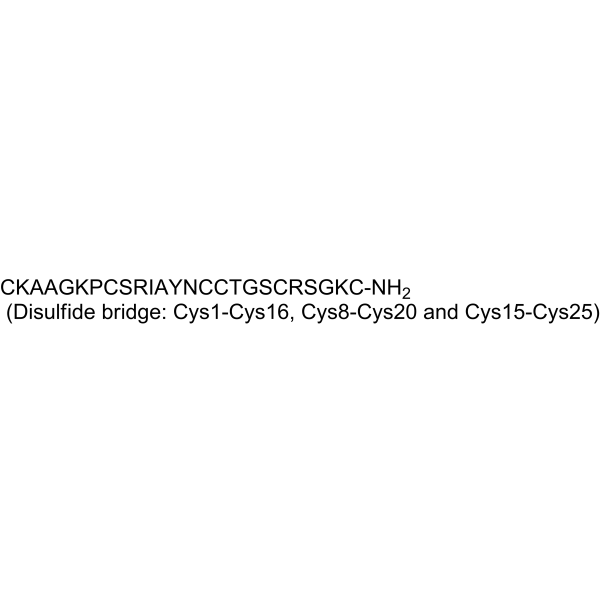
- HY-P5144
-
-

- HY-P5145
-
-
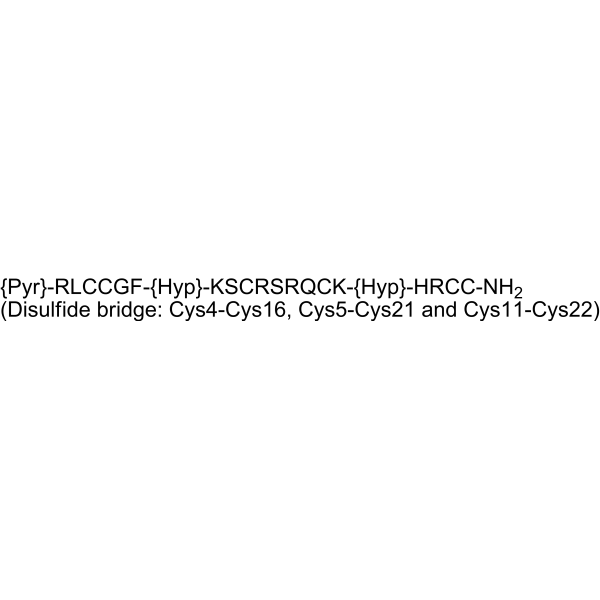
- HY-P5160
-
|
PhlTx1
|
Sodium Channel
|
Inflammation/Immunology
|
|
Phlotoxin-1 (PhlTx1) is a 34-amino acid and 3-disulfide bridge peptide. Phlotoxin-1 can be isolated from Phlogiellus genus spider. Phlotoxin-1 is an antinociceptive agent by inhibiting NaV1.7 channel .
|
-

- HY-P5154
-
|
|
Potassium Channel
|
Neurological Disease
|
|
Tamapin is a venom peptide, targeting to small conductance Ca(2+)-activated K(+) (SK) channels. Tamapin is a selctive blocker of SK2 (Potassium Channel). Tamapin inhibits SK channel-mediated currents in pyramidal neurons of the hippocampus. Tamapin can be isolated from the Indian red scorpion (Mesobuthus tamulus) .
|
-
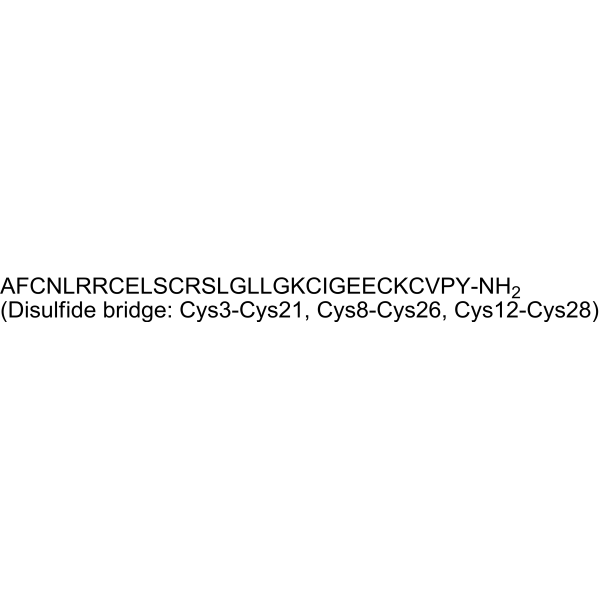
- HY-P5147
-
|
|
nAChR
|
Neurological Disease
|
|
α-Conotoxin GID is a paralytic peptide neurotoxin and a selective antagonist of nAChR, with IC50s of 5 nM (α7), 3 nM (α3β2), 150 nM (α4β2), respectively. α-Conotoxin GID is small disulfide-rich peptide, with potential to inhibit chronic pain. α-Conotoxin GID contains a C-terminal carboxylate, thus substitution with a C-terminal carboxamide results in loss of α4β2 nAChR. α-Conotoxin GID can be isolated from the Conus species .
|
-
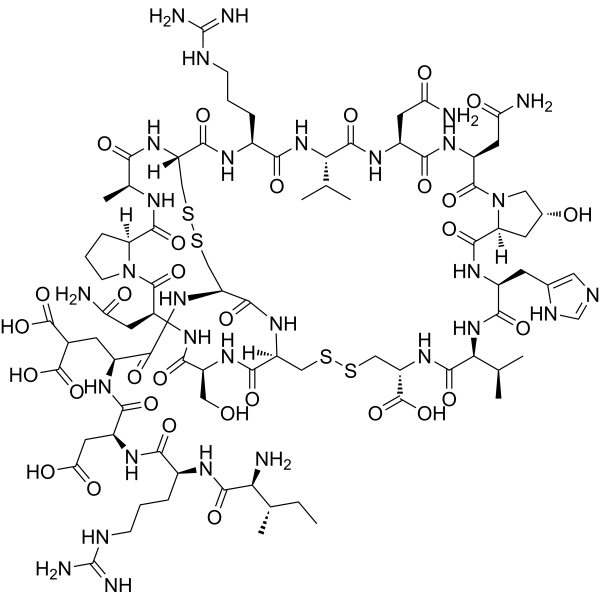
- HY-P5149
-
|
αC-PrXA
|
nAChR
|
Neurological Disease
|
|
αC-Conotoxin PrXA is a paralytic peptide neurotoxin and a competitive nAChR antagonist, with IC50s of 1.8 nM (α1β1εδ, adult) and 3.0 nM (α1β1γδ, fetal), respectively. αC-Conotoxin PrXA competes with α-bungarotoxin at the α/δ and α/γ subunit interfaces of the nAChR, shows high specificity against neuromuscular nAChR .
|
-

- HY-P5148
-
|
|
nAChR
|
Neurological Disease
|
|
α-Conotoxin BuIA is a paralytic peptide neurotoxin and a competitive nAChR antagonist, with IC50s of 0.258 nM (α6/α3β2), 1.54 nM (α6/α3β4), 5.72 nM (α3β2), respectively. α-Conotoxin BuIA can be used to distinguish nAChRs containing β2- and β4-subunit, respectively. α-Conotoxin BuIA distinguishes among αxβ2 nAChRs with a rank order potency of α6>α3>α2>α4 .
|
-
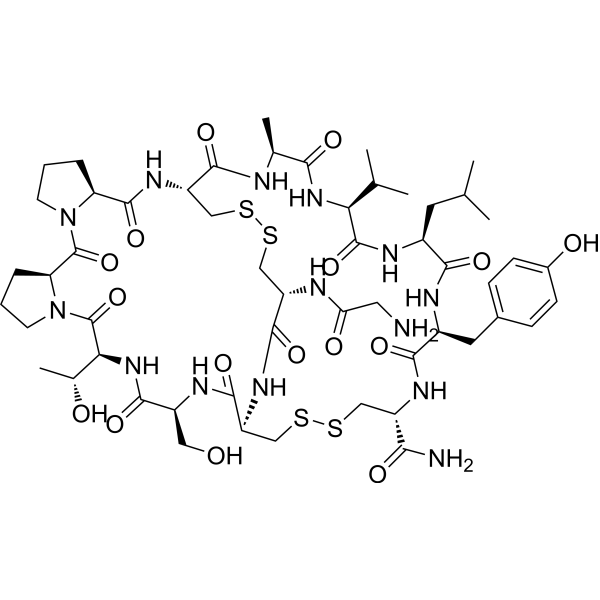
- HY-P5152
-
|
|
Sodium Channel
|
Neurological Disease
|
|
Scorpion toxin Tf2 is a β-scorpion toxin, which is firstly identified in the venom of the Brazilian scorpion Tityus fasciolatus. Scorpion toxin Tf2 is a Nav1.3 activator, which is a neuronal voltage-gated sodium (Nav) subtype implicated in epilepsy and nociception. Scorpion toxin Tf2 enhances hNav1.3 activation voltage and opens the channel at resting membrane potentials .
|
-

- HY-P5155
-
|
|
Potassium Channel
|
Neurological Disease
|
|
Stromatoxin 1 is an inhibitor of Potassium Channel, a peptide which can be isolated from tarantulas. Stromatoxin 1 selectively inhibits K(V)2.1, K(V)2.2, K(V)4.2, and K(V)2.1/9.3 channels. K(V)2.1 and K(V)2.2, but not K(V)4.2, channel subunits play a key role in opposing both myogenic and neurogenic urinary bladder smooth muscle (UBSM) contractions in rats .
|
-
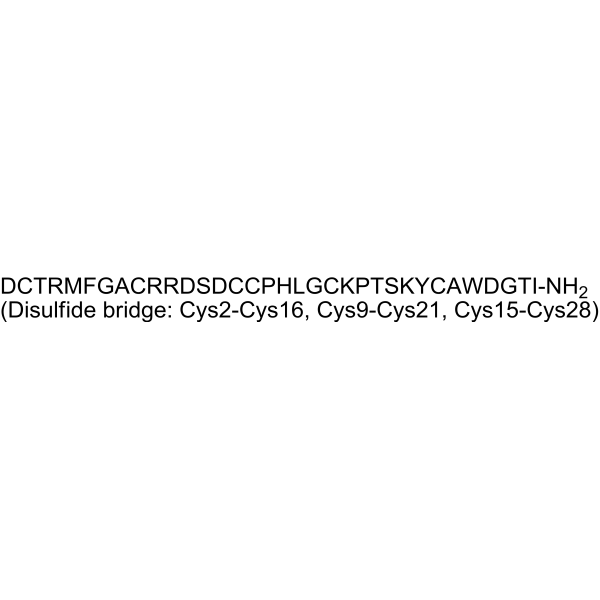
- HY-P5157
-
|
|
Potassium Channel
|
Neurological Disease
|
|
BmP02 is a selective Kv1.3 channel blocker and a highly-selective Kv4.2 modulator, which can be isolated from Chinese scorpion (Buthus martensi Karsch) venom. BmP02 also delays the inactivation of Kv4.2 in HEK293T cells, with an EC50 value of ~850 nM. BmP02 inhibits the transient outward potassium currents (Ito) in ventricular muscle cells .
|
-

- HY-P5184
-
|
HNTX-IV
|
Sodium Channel
|
Neurological Disease
|
|
Hainantoxin-IV is a specific antagonist of Sodium Channel, targeting to tetrodotoxin-sensitive (TTX-S) voltage-gated sodium channels. His28 and Lys32 are the key resiudes of Hainantoxin-IV for binding with target, while Hainantoxin-IV adopts an inhibitor cystine knot motif .
|
-
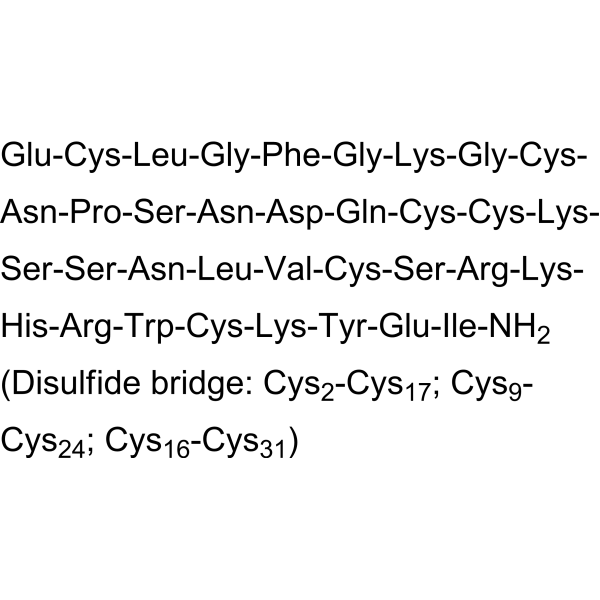
- HY-P5183
-
|
|
Sodium Channel
|
Neurological Disease
|
|
Hm1a is a disulfide-rich spider-venom peptide, and a NaV1.1 activator. Hm1a restores the function of inhibitory interneurons in Dravet syndrome (DS) mouse model .
|
-

- HY-P3055
-
|
DTX-I
|
Potassium Channel
|
Neurological Disease
Cancer
|
|
Dendrotoxin-I is a potent K + channels blocker and targets voltage-gated potassium channel subunits KV1.1 and KV1.2. Dendrotoxin-I is a neurotoxin isolated from thevenom of Dendroaspis snakes .
|
-

- HY-105168
-
|
|
Endothelin Receptor
|
Cardiovascular Disease
|
|
TAK 044 is an antagonist of Endothelin Receptor. TAK 044 strongly inhibits ET-induced deterioration in various animal models. TAK 044 can be used in study ET-related diseases such as acute myocardial infarction,acute renal failure, acute hepatic malfunction, and subarachnoid hemorrhage .
|
-
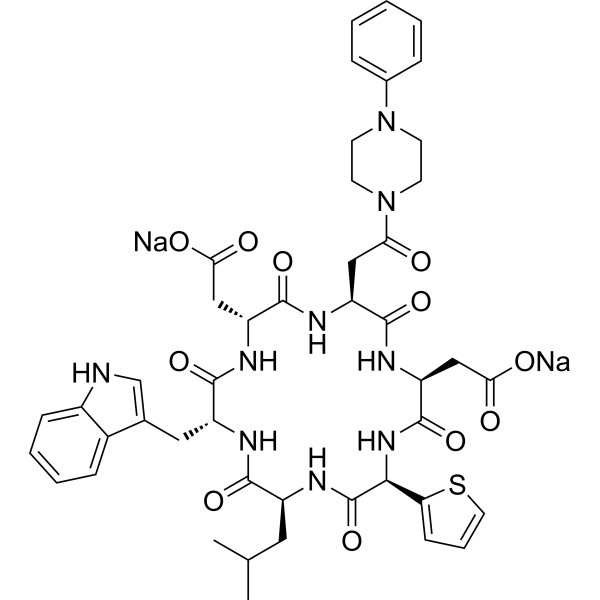
- HY-P1264F
-
|
|
nAChR
|
Neurological Disease
|
|
FITC-α-Bungarotoxin is the FITC labelled α-Bungarotoxin (HY-P1264). α-Bungarotoxin is a competitive antagonist at nicotinic acetylcholine receptors (nAChRs) .
|
-

- HY-P1264F1
-
|
|
nAChR
|
Neurological Disease
|
|
Biotin-α-Bungarotoxin is the Biotin labelled α-Bungarotoxin (HY-P1264). α-Bungarotoxin is a competitive antagonist at nicotinic acetylcholine receptors (nAChRs) .
|
-

- HY-P1285
-
|
Con-R
|
iGluR
|
Neurological Disease
|
|
Conantokin R (Con-R) is an NMDA receptor peptide antagonist with an IC50 of 93 nM. Conantokin R binds Zn 2+ and Mg 2+ with Kds of 0.15 μM and 6.5 μM, respectively. Conantokin R shows anticonvulsant activity .
|
-

- HY-P2699
-
|
GrTx; ω-GsTx SIA
|
Calcium Channel
|
Neurological Disease
|
|
ω-Grammotoxin SIA (GrTx) is P/Q and N-type voltage-gated Calcium channels inhibitor. ω-Grammotoxin SIA is also a protein toxin that can be obtained from spider venom. ω-Grammotoxin SIA has the potential to study neurological diseases as well as cardiovascular diseases .
|
-

- HY-P5849
-
|
αA-OIVA
|
nAChR
|
Neurological Disease
|
|
αA-Conotoxin OIVA (αA-OIVA) is a selective nAChR antagonist with an IC50 of 56 nM against mammalian fetal muscle nAChR. αA-Conotoxin OIVA is a peptide that can be derived from conotoxin. αA-Conotoxin OIVA paralyzes muscles .
|
-
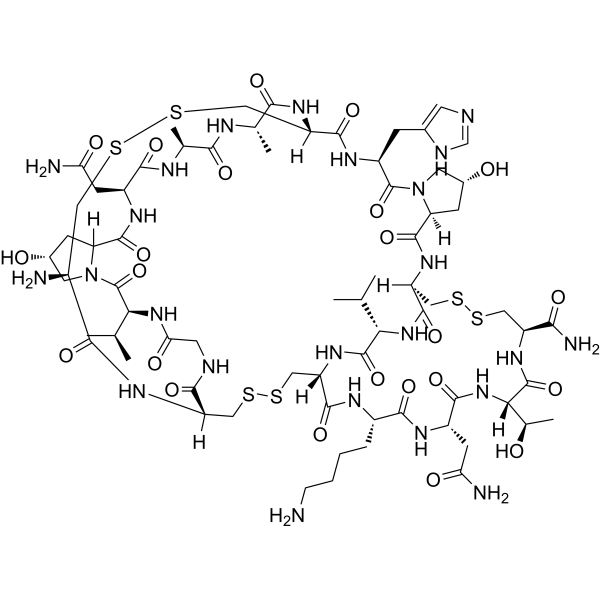
- HY-P5851
-
|
|
Biochemical Assay Reagents
|
Neurological Disease
|
|
AaHI is a neurotoxin that can be obtained from the venom of the North African scorpion Androctonus australis hector. AaHI can be used as a tool for the development of active substances with toxin-neutralizing capabilities .
|
-
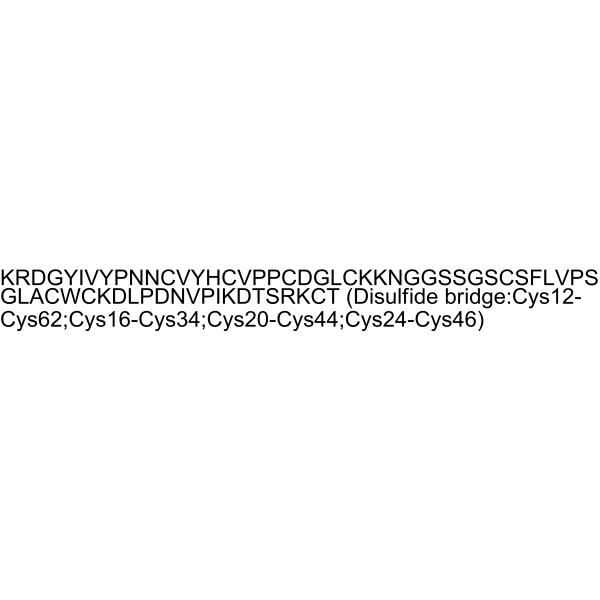
- HY-P5863
-
|
Mamb-2
|
Sodium Channel
|
Neurological Disease
|
|
Mambalgin-2 (Mamb-2) is an acid-sensitive ion channels (ASICs) inhibitor and a venom peptide. Mambalgin-2 can be obtained from the venom of the African black mamba. Mambalgin-2 can be used in the study of pain and neurological diseases .
|
-

- HY-P5782
-
|
|
Sodium Channel
|
Neurological Disease
|
|
δ-Theraphotoxin-Hm1a toxin is a selective Nav1.1 activator. δ-Theraphotoxin-Hm1a toxin elicits pain and touch sensitivity. δ-Theraphotoxin-Hm1a toxin can be used for the research of irritable bowel syndrome .
|
-

- HY-P5795
-
|
|
Sodium Channel
Potassium Channel
|
Neurological Disease
|
|
GsAF-I is a potent Nav and hERG1 channels blocker with IC50s of 0.36, 0.6, 1.28, 0.33, 1.2, 0.04 and 4.8 μM against Nav1.1, Nav1.2, Nav1.3, Nav1.4, Nav1.6, Nav1.7 and hERG1, respectively .
|
-

- HY-P5796
-
|
|
Calcium Channel
|
Neurological Disease
|
|
FS-2 is a potent and specific L-type CaV channel inhibitor. FS-2 inhibits high K + or glucose induced L-type Ca 2+ influx in RIN beta cells .
|
-

- HY-P5804
-
|
|
Calcium Channel
|
Neurological Disease
|
|
ω-Conotoxin CVIF is a selective Cav2.2 channel inhibitor with an IC50 of 34.3 nM in rat isolated DRG neurons. ω-Conotoxin CVIF block of Cav2.2 channels is weakly reversible .
|
-

- HY-P5809
-
-
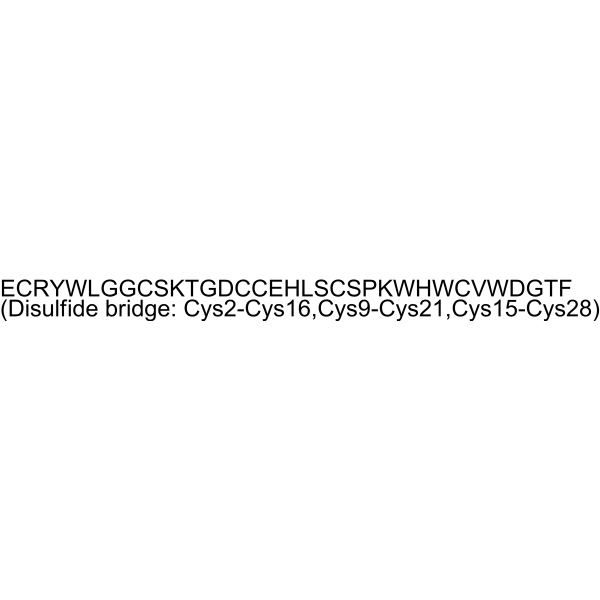
- HY-P5810
-
|
CcoTx2; β-TRTX-cm1b
|
Sodium Channel
|
Neurological Disease
|
|
Ceratotoxin-2 (CcoTx2) is a voltage-gated sodium channel blocker with IC50s of 8 nM and 88 nM against Nav1.2/β1 and Nav1.3/β1, respectively .
|
-

- HY-P5823
-
|
|
nAChR
|
Neurological Disease
|
|
Azemiopsin is a potent nicotinic acetylcholine receptor (nAChR) inhibitor with IC50s of 0.18 μM and 22 μM against T. californica nAChR and human α7 nAChR, respectively. Azemiopsin blocks acetylcholine-induced currents in Xenopus oocytes heterologously expressing human muscle-type nAChR .
|
-

- HY-P5828
-
-

- HY-P5833
-
|
κ-Bgt
|
nAChR
|
Neurological Disease
|
|
κ-Bungarotoxin (κ-Bgt) is a potent, selective, and slowly reversible antagonist of α3β2 neuronal nicotinic acetylcholine receptors with an IC50 of 2.30 nM .
|
-

- HY-P5835
-
|
|
Potassium Channel
|
Neurological Disease
|
|
δ-Dendrotoxin is a K + channel blocker that can be obtained from the venom of the black mamba snake. δ-Dendrotoxin can be used in the study of neurological diseases .
|
-

- HY-P5839
-
|
|
nAChR
|
Neurological Disease
|
|
α-Conotoxin MrIC is an α7nAChR biased agonist. α-Conotoxin MrIC exclusively activates α7nAChR regulated by type II positive allosteric modulators, including PNU120596. α-Conotoxin MrIC can be used to study neurological diseases and also to probe the pharmacological properties of α7nAChR .
|
-
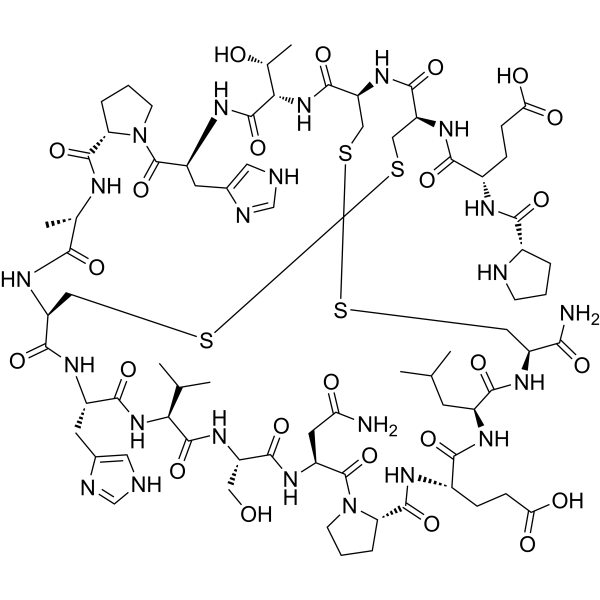
- HY-P5841
-
|
|
Liposome
|
Neurological Disease
|
|
α-Conotoxin LtIA is an α3β2 nAChR blocker (IC50=9.8 nM), that can be obtained from Conus litteratus venom. Alpha-Conotoxin LtIA can be used in the study of neurological diseases (such as Parkinson's disease, pain) .
|
-
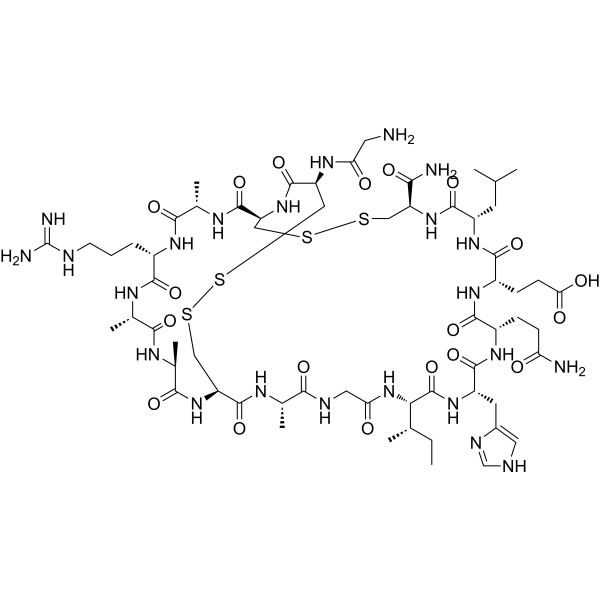
- HY-P5844
-
|
|
nAChR
|
Neurological Disease
|
|
α-Conotoxin AuIA is a potent and selective α3β4 n-nAChR inhibitor. α-Conotoxin AuIA is a α-conotoxin that can be isolated from Conus aulicus .
|
-
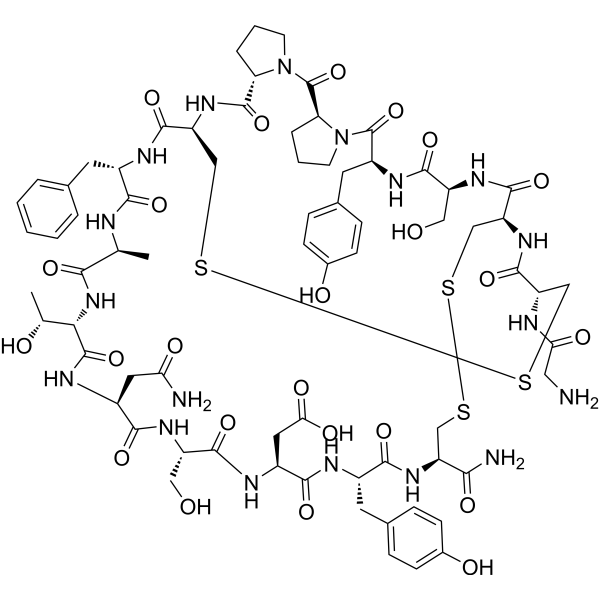
- HY-P5845
-
|
α-RgIA
|
nAChR
|
Neurological Disease
|
|
α-Conotoxin RgIA (α-RgIA) is a specific α9α10 nAChR antagonist. α-Conotoxin RgIA can be obtained from Conus regius venom. α-Conotoxin RgIA can be used in the study of neurological diseases .
|
-
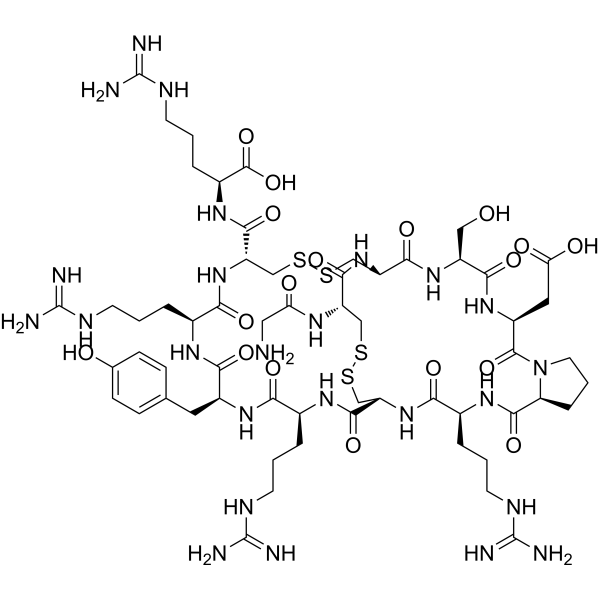
- HY-P5846
-
|
MT3
|
mAChR
Adrenergic Receptor
|
Neurological Disease
|
|
Muscarinic toxin 3 (MT3) is a potent and non-competitive mAChR and adrenoceptors antagonist with pIC50s of 6.71, 8.79, 8.86, 7.57, 8.13, 8.49, <6.5, 7.29 against M1, M4, α1A, α1B, α1D,α2A,α2B and α2C receptors, respectively. Muscarinic toxin 3 displays prominent adrenoceptor activity .
|
-

- HY-P5847
-
-

- HY-P5848
-
|
|
nAChR
|
Neurological Disease
|
|
αO-Conotoxin GeXIVA is a potent α9α10 nAChR antagonist with an IC50 of 12 nM against rat α9α10. αO-Conotoxin GeXIVA shows analgesic in animal models of pain .
|
-
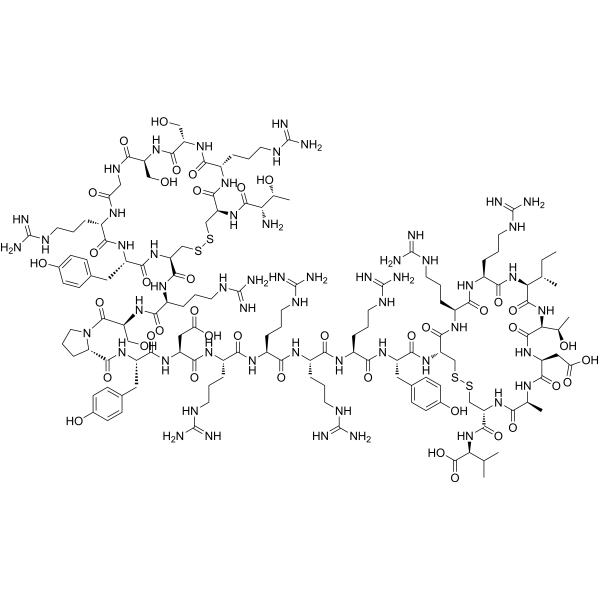
- HY-P5850
-
|
|
nAChR
|
Neurological Disease
|
|
α-Conotoxin Bt1.8 is a potent α6/α3β2β3 and α3β2 nAChRs inhibitor with IC50s of 2.1 nM and 9.4 nM against rat α6/α3β2β3 and α3β2, respectively .
|
-

- HY-P5853
-
|
|
Potassium Channel
|
Inflammation/Immunology
|
|
Aam-KTX is a Kv channel inhibitor with IC50 values of 1.1 nM and >750 nM for Kv1.3 and Kv1.1, respectively. Aam-KTX is a toxic peptide obtained from the venom of the scorpion Mesobuthus eupeus. Aam-KTX has potential in autoimmune diseases research .
|
-

- HY-P5855
-
|
|
Sodium Channel
|
Neurological Disease
|
|
μ-Conotoxin SxIIIC is an irreversible NaV channel inhibitor that can be obtained from the Conus striolatus. μ-Conotoxin SxIIIC can be used in the study of neurological diseases such as chronic pain .
|
-
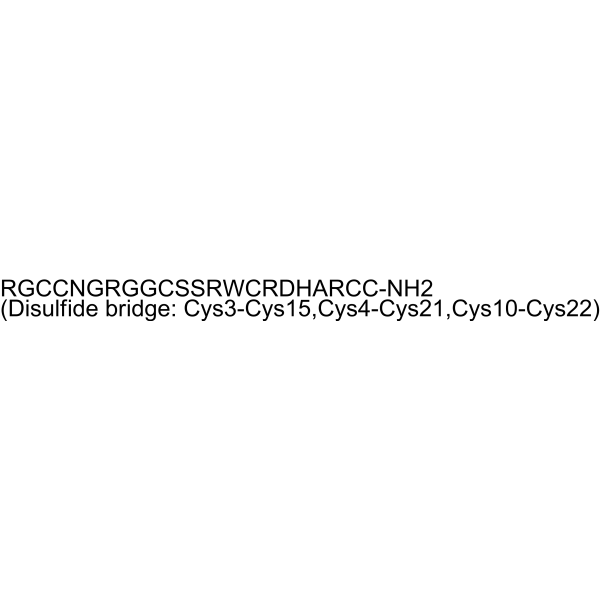
- HY-P5856
-
|
|
nAChR
|
Neurological Disease
|
|
αA-Conotoxin PIVA is a selective mouse musclenAChR inhibitor with IC50 for adult and fetal mouse musclenAChR sub> values are 2.3 nM and 22 nM respectively. αA-Conotoxin PIVA can be used in the study of neurological diseases.
|
-

- HY-P5857
-
|
Micrurotoxin 2
|
GABA Receptor
|
Neurological Disease
|
|
MmTx2 toxin is a GABAA receptor modulator that enhances GABAA receptor sensitivity to agonists. MmTx2 toxin can be obtained from venom of coral snake. MmTx2 toxin can be used in the study of neurological diseases such as epilepsy, schizophrenia and chronic pain .
|
-

- HY-P5858
-
|
|
Sodium Channel
|
Neurological Disease
|
|
μ-Conotoxin SIIIA is a tetrodotoxin (TTX)-resistant sodium channel blocker. μ-Conotoxin SIIIA is a toxic peptide that can be obtained from the venom of Conus snails. μ-Conotoxin SIIIA can be used in the study of neurological diseases, such as neuropathic pain .
|
-

- HY-P5859
-
|
α-PMTX
|
Biochemical Assay Reagents
|
Neurological Disease
|
|
α-Pompilidotoxin (α-PMTX) is a neurotoxin that can be obtained from the venom of Anoplius safnariensis. α-Pompilidotoxin reversibly and dose-dependently enhances excitatory postsynaptic currents (EPSCs). α-Pompilidotoxin is a useful tool in the field of neuroscience research .
|
-
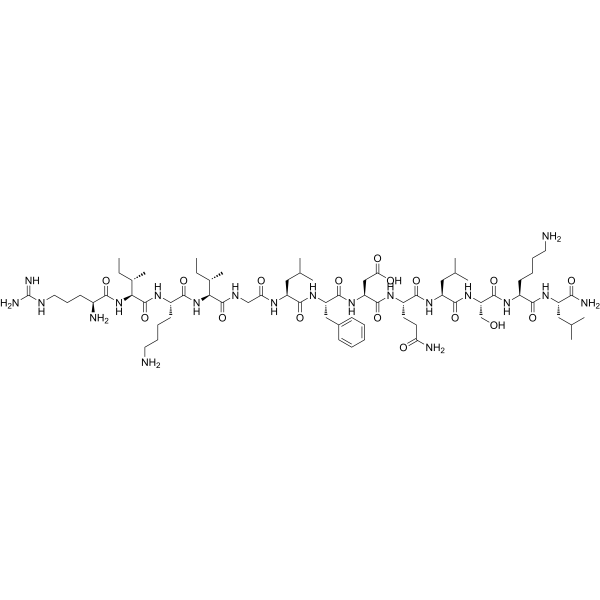
- HY-P5860
-
|
Micrurotoxin 1
|
GABA Receptor
|
Neurological Disease
|
|
MmTx1 toxin (Micrurotoxin 1) is an allosteric GABAA receptor modulator that increases GABAA receptor susceptibility to agonist .
|
-
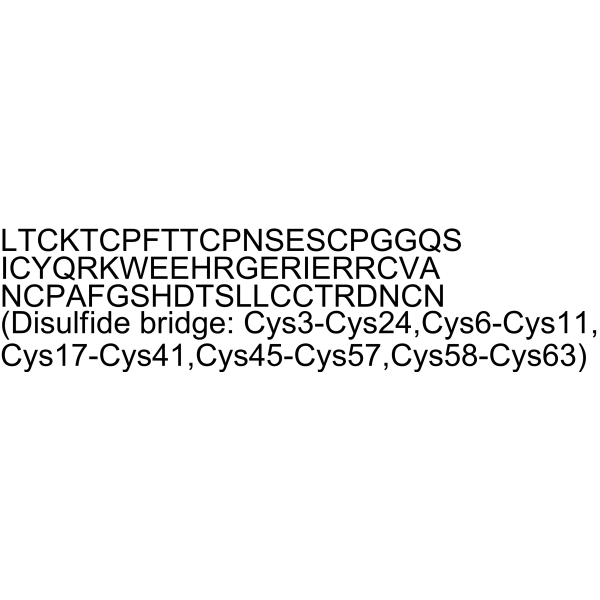
- HY-P5861
-
-
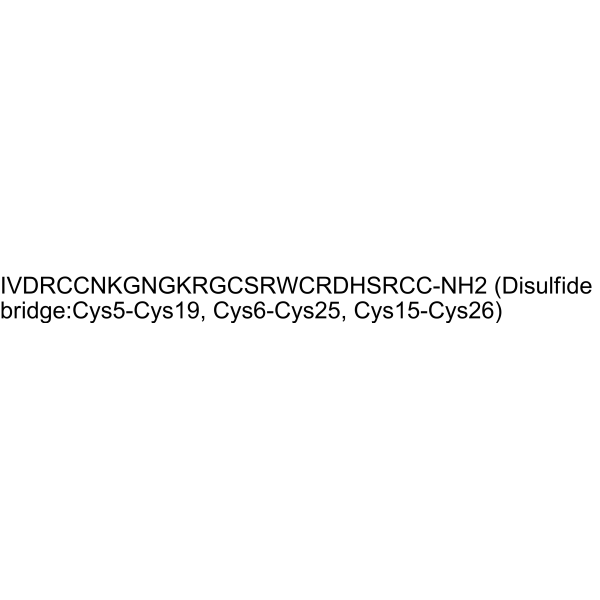
- HY-P5862
-
|
Mu-Conotoxin BuIIIB
|
Sodium Channel
|
Neurological Disease
|
|
μ-Conotoxin BuIIIB (Mu-Conotoxin BuIIIB) is a mammalian neuronal voltage-gated sodium channel (VGSC) blocker. μ-Conotoxin BuIIIB can be obtained from the venom of Cone snails and is a probe for ion channel function research. μ-Conotoxin BuIIIB can be used in the study of neurological diseases such as pain .
|
-

- HY-P5864
-
|
|
Sodium Channel
|
Neurological Disease
|
|
μ-Conotoxin BuIIIA (Mu-Conotoxin BuIIIA) is a voltage-gated sodium channel (VGSC) blocker. μ-Conotoxin BuIIIA is a toxic peptide that can be obtained from the venom of Cone snails. μ-Conotoxin BuIIIA can be used in the study of neurological diseases .
|
-

- HY-P5865
-
|
Theraphotoxin-Tap1a; TRTX-Tap1a; µ/ω-TRTX-Tap1a
|
Sodium Channel
|
Neurological Disease
|
|
Tap1a (Theraphotoxin-Tap1a) is a spider venom peptide that inhibits sodium channels with IC50s of 80 nM and 301 nM against Nav1.7 and Nav1.1, respectively. Tap1a shows analgesic effects .
|
-
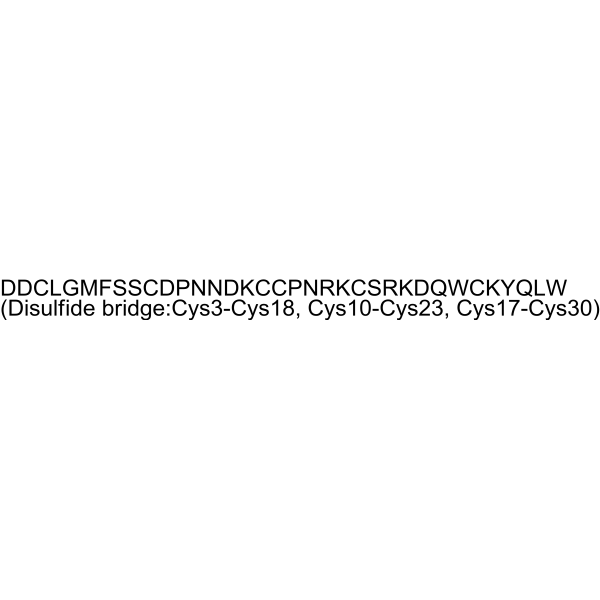
- HY-P5868
-
|
|
Sodium Channel
|
Neurological Disease
|
|
mHuwentoxin-IV is a naturally modified Huwentoxin-IV (HY-P1220). mHuwentoxin-IV inhibits tetrodotoxin-sensitive (TTX-S) voltage-gated sodium channels of dorsal root ganglion neurons with an IC50 of 54.16 nM. mHuwentoxin-IV inhibition of tetrodotoxin-sensitive sodium channels is not reversed by strong depolarization voltages .
|
-
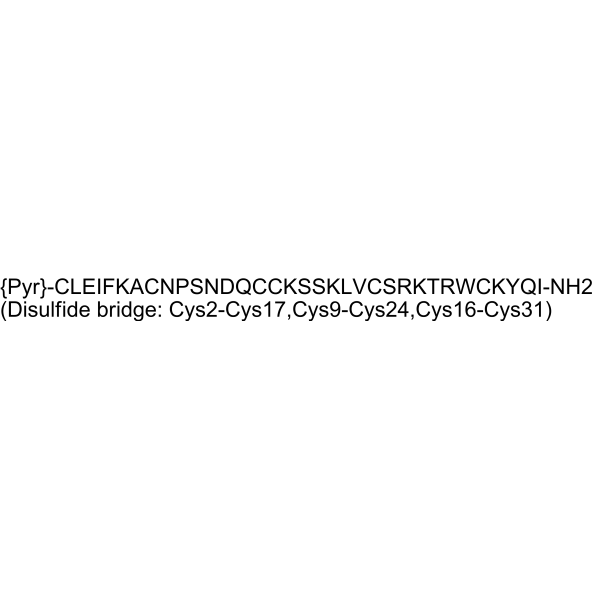
- HY-P5869
-
|
|
Calcium Channel
Sodium Channel
|
Neurological Disease
|
|
Kurtoxin is a selective Cav3 (T-type) voltage-gated Ca 2+ channel gating inhibitor with a Kd of 15 nM for Cav3.1 (α1G T-type) Ca 2+ channel. Kurtoxin can interact with high affinity with native neuronal high-threshold L-type, N-type, and P-type Ca 2+ channels in central and peripheral neurons. Kurtoxin also shows cross-reactivity with voltage-gated Na + channel .
|
-

- HY-P5870
-
|
|
Potassium Channel
|
Inflammation/Immunology
|
|
KTX-Sp2 is a potassium channel toxin. KTX-Sp2 effectively blocks three types of exogenous voltage-gated potassium channels: Kv1.1, Kv1.2 and Kv1.3. Ktx-Sp2 inhibits endogenous Kv1.3 and suppresses Ca 2+ signaling in Jurkat T cells. Ktx-Sp2 inhibits IL-2 secretion from activated Jurkat T cells .
|
-

- HY-P5871
-
|
JzTx-XII
|
Potassium Channel
|
Others
|
|
Jingzhaotoxin-XII (JzTx-XII) is a specific Kv4.1 channel inhibitor with an IC50 of 0.363 μM. Jingzhaotoxin-XII interacts with the channels by modifying the gating behavior .
|
-
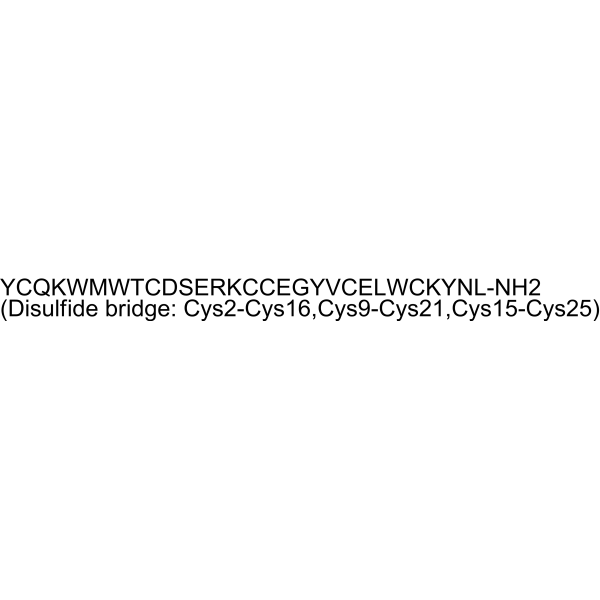
- HY-P5872
-
|
JZTX-XI
|
Sodium Channel
|
Neurological Disease
|
|
Jingzhaotoxin XI (JZTX-XI) is a sodium conductance inhibitor with an IC50 of 124 nM. Jingzhaotoxin XI slows the fast inactivation (EC50=1.18±0.2 μM) of Nav1.5 expressed in Chinese hamster ovary (CHO-K1) cells .
|
-
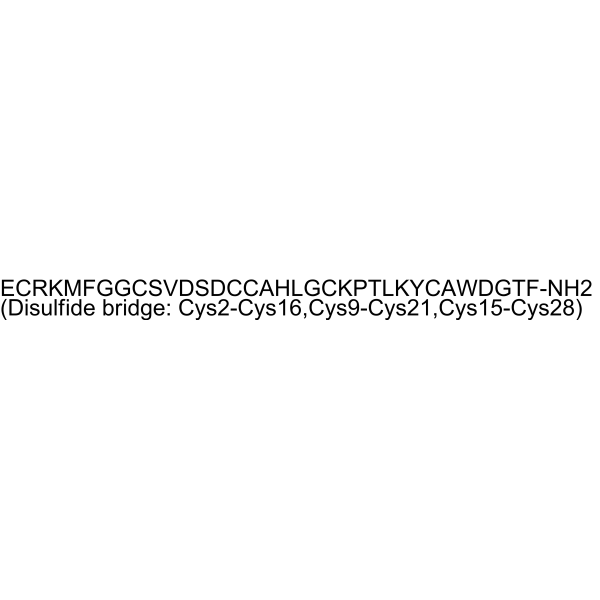
- HY-P5873
-
|
JZTX-X
|
Potassium Channel
|
Neurological Disease
|
|
Jingzhaotoxin-X (JZTX-X) is a selective Kv4.2 and Kv4.3 potassium channels inhibitor. Jingzhaotoxin-X causes long-lasting mechanical hyperalgesia .
|
-
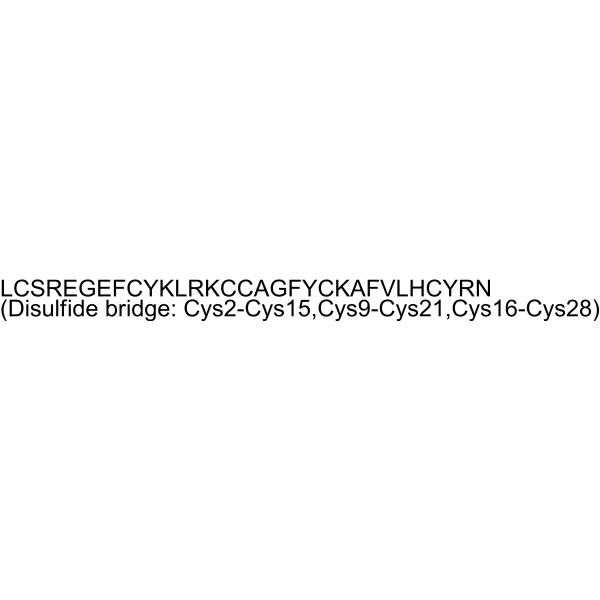
- HY-P5899
-
-

- HY-P5900
-
|
m3-HwTx-IV
|
Sodium Channel
|
Neurological Disease
|
|
m3-Huwentoxin IV (m3-HwTx-IV) is a potent NaV inhibitor with IC50s of 3.3, 6.8, 7.2, 8.4, 11.9 and 369 nM against hNaV1.7, hNaV1.6, hNaV1.3, hNaV1.1, hNaV1.2 and hNaV1.4, respectively in QPatch assay. m3-Huwentoxin IV dose-dependently suppresses spontaneous pain induced by the NaV1.7 activator OD1 in a rodent pain model .
|
-
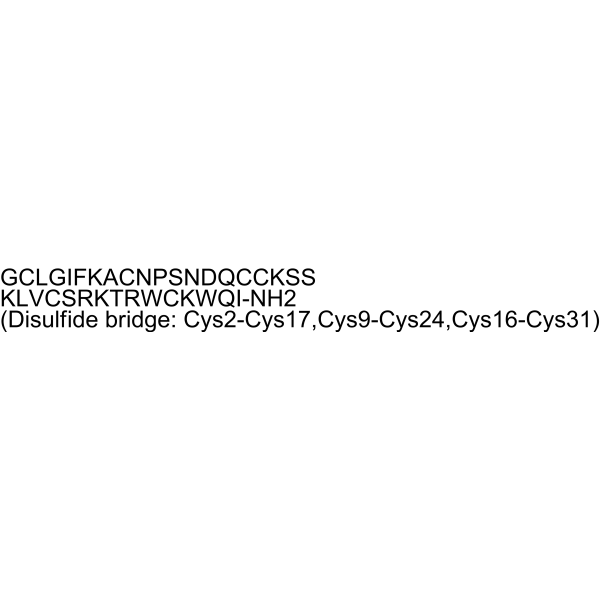
- HY-P5902
-
-

- HY-P1410B
-
-
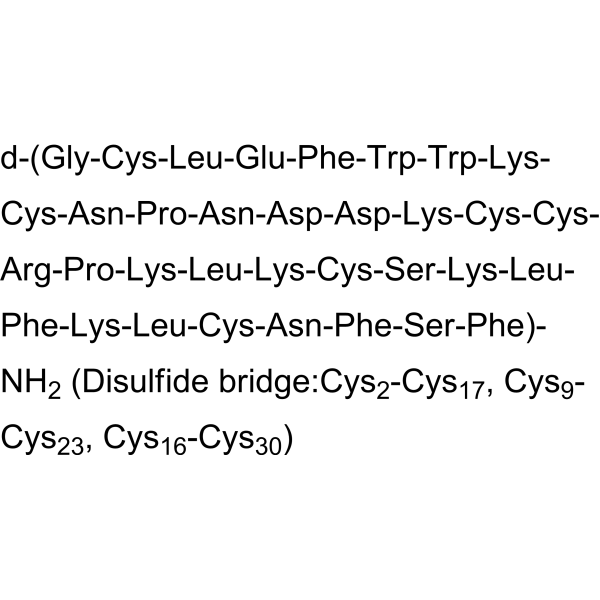
- HY-P5797
-
-

- HY-P2785
-
-

- HY-P2949
-
|
|
Potassium Channel
|
Cancer
|
|
Pandinotoxin Kα, isolated from the venom of Pandinus imperator, is the inhibitor of A-type potassium channel .
|
-

- HY-P3065
-
|
|
Calcium Channel
|
Neurological Disease
|
|
Calcicludine is a protein toxin from the venom of the green mamba Dendroaspis angusticeps that inhibits high-voltage-activated calcium channel, especially L-type calcium channel with the IC50 of 88 nM. Calcicludine has role in excitatory synaptic transmission .
|
-
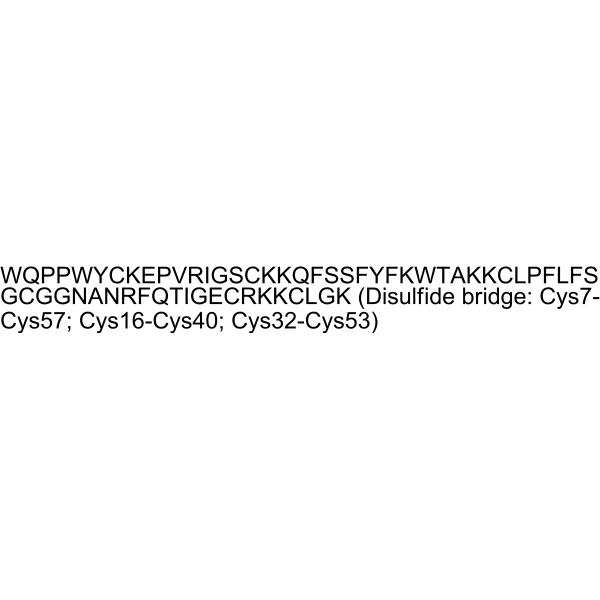
- HY-P3111
-
|
|
Potassium Channel
|
Others
|
|
Slotoxin, a peptide from Centruroides noxius Hoffmann scorpion venom, blocks high conductance calcium-activated potassium channel, with Kd of 1.5 nM[1].
|
-

- HY-P3269
-
|
|
Calcium Channel
|
Others
|
|
Calciseptine, a natural?neurotoxin?isolated from the black mamba Dendroaspis p. polylepis venom. Calciseptine consists of 60 amino acids with four disulfide bonds. Calciseptine specifically blocks L-type?calcium channel[1].
|
-
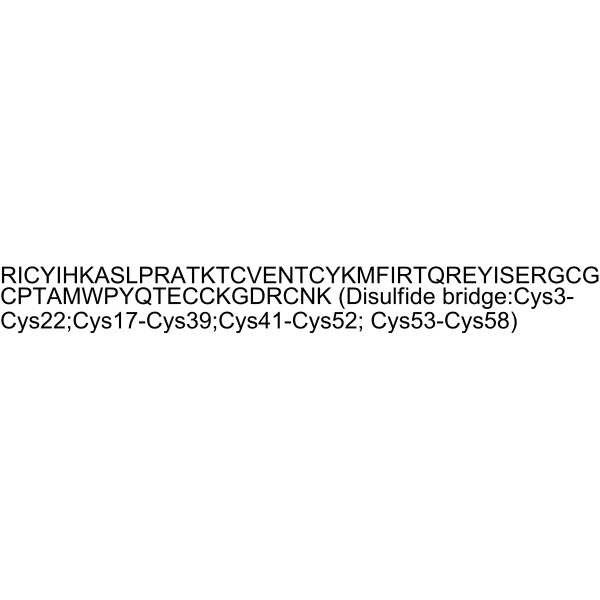
- HY-P5788
-
|
|
Potassium Channel
|
Neurological Disease
|
|
Hemitoxin, a scorpion-venom peptide, is a K + channel blocker. Hemitoxin blocks rat Kv1.1, Kv1.2 and Kv1.3 channels expressed in Xenopus oocytes with IC50 values of 13 nM, 16 nM and 2 nM, respectively .
|
-

- HY-P5790
-
|
|
Sodium Channel
|
Neurological Disease
|
|
μ-TRTX-Hd1a, a spider venom, is a selective NaV 1.7 inhibitor. μ-TRTX-Hd1a is a gating modifier that inhibits human NaV 1.7 by interacting with the S3b-S4 paddle motif in channel domain II .
|
-

- HY-P5793
-
-

- HY-P5799
-
|
SNX-238
|
Calcium Channel
|
Neurological Disease
|
|
ω-Conotoxin MVIID (SNX-238) is a Conus peptide that blocks an ω-Conotoxin-GVIA-sensitive, high-threshold Ca 2+ current in fish retinal ganglion cells .
|
-

- HY-P5803
-
|
|
Bacterial
|
Infection
|
|
Pardaxin P5 is an antimicrobial peptide that inhibits Escherichia coli with a MIC value of 13 μM .
|
-

- HY-P5816
-
|
|
Sodium Channel
|
Neurological Disease
|
|
BmK-M1 is a scorpion toxin, and is composed of 64 amino acids cross-linked by four disulfide bridges. BmK-M1 inhibits Na + channel and can be considered both as a cardiotoxin and a neurotoxin .
|
-

- HY-P5925
-
|
SsTx Toxin
|
Potassium Channel
|
Inflammation/Immunology
|
|
Ssm Spooky Toxin from?Scolopendra mutilans, exhibits lethal toxicity in hematological and respiratory systems by potently inhibiting KCNQ (voltage-gated potassium channel family 7) channels, with IC50? of 2.8 μM, 5.26 μM and 0.1-0.3 M for Kv7.4, Kv1.3, and Shal channel, respectivily. Ssm Spooky Toxin inhibits cytokine generation by specifically acting on the KV1.3 channel in T cells. Ssm Spooky Toxin plays an essential role in the centipede’s circulatory system .
|
-

- HY-P5931
-
|
Potassium channel toxin alpha-KTx 6.13; SPX; α-KTx6.13
|
Potassium Channel
|
Inflammation/Immunology
|
|
Spinoxin isolated from the venom of scorpion Heterometrus spinifer, is a 34-residue peptide neurotoxin cross-linked by four disulfide bridges. Spinoxin is a potent inhibitor of Kv1.3 potassium channel (IC50 = 63 nM), considering to be valid molecular targets in the diagnostics and therapy of various autoimmune disorders and cancers .
|
-
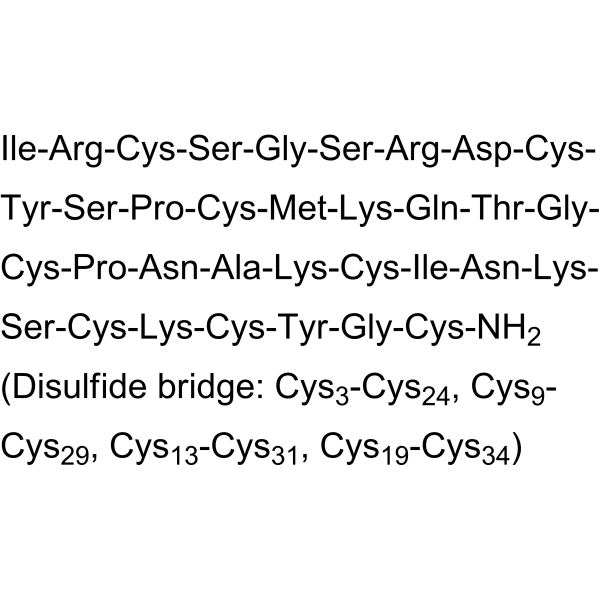
- HY-P3014
-
|
|
Potassium Channel
|
Others
|
|
Hongotoxin-1, isolated from venom of Centruroides limbatus, is the inhibitor of potassium channel, with IC50 for? Kv1.1, Kv1.2, Kv1.3, and Kv1.6 of 31 pM, 170 pM, 86 pM,and 6000 pM, respectively .
|
-

- HY-P5180
-
|
|
Sodium Channel
|
Neurological Disease
|
|
Jingzhaotoxin-V is a peptide that inhibits potassium currents in Xenopus laevis oocytes with an IC50 value of 604.2 nM. Jingzhaotoxin-V also inhibits tetrodotoxin-resistant and tetrodotoxin-sensitive sodium currents in rat dorsal root ganglion neurons with IC50 values of 27.6 and 30.2 nM, respectively .
|
-
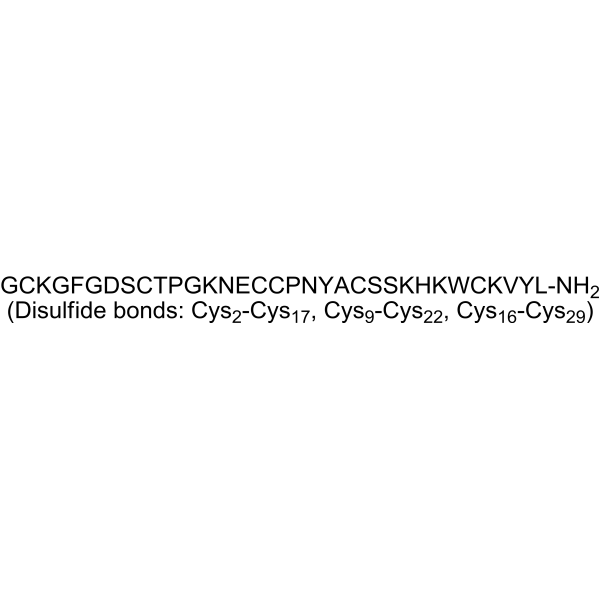
- HY-P5182
-
|
|
Potassium Channel
|
Inflammation/Immunology
|
|
HsTX1, from the scorpion Heterometrus spinnifer, is a 34-residue, C-terminally amidated peptide cross-linked by four disulfide bridges. HsTX1, an the inhibitor of potassium channel, with IC50 for Kv1.3 of 12 pM inhibits TEM cell activation and attenuates inflammation in autoimmunity .
|
-

- HY-P5770
-
|
|
Sodium Channel
|
Neurological Disease
|
|
Jingzhaotoxin-V, a 29-residue polypeptide, is derived from the venom of the spider Chilobrachys jingzhao. Jingzhaotoxin-V inhibits tetrodotoxin-resistant and tetrodotoxin-sensitive sodium currents in rat dorsal root ganglion neurons with IC50 values of 27.6 nM and 30.2 nM, respectively. Jingzhaotoxin-V also inhibits Kv4.2 potassium currents expressed in Xenpus Laevis oocytes (IC50 of 604.2 nM) .
|
-

- HY-P5771
-
|
|
Sodium Channel
|
Neurological Disease
|
|
Jingzhaotoxin-IX, a C-terminally amidated peptide composed of 35 amino acid residues, is a neurotoxin. Jingzhaotoxin-IX inhibits voltage-gated sodium channels (both tetrodotoxin-resistant and tetrodotoxin-sensitive isoforms) and Kv2.1 channel. Jingzhaotoxin-IX has no effect on delayed rectifier potassium channel Kv1.1, 1.2 and 1.3 .
|
-

- HY-P5772
-
|
|
Sodium Channel
|
Neurological Disease
|
|
Jingzhaotoxin-II, a 32 amino acid residues including two acidic and two basic residues, is a neurotoxin. Jingzhaotoxin-II inhibits voltage-gated sodium channels (VGSC) that significantly slows rapid inactivation of TTX-resistant (TTX-R) VGSC on cardiac myocytes with the IC50 of 0.26 μM .
|
-

- HY-P5773
-
|
|
Sodium Channel
|
Neurological Disease
|
|
Jingzhaotoxin-34, a 35-residue polypeptide, is a neurotoxin. Jingzhaotoxin-34 inhibits tetrodotoxin-sensitive (TTX-S) sodium currents (IC50 of ~85 nM) while having no significant effects on tetrodotoxin-resistant (TTX-R) sodium currents on rat dorsal root ganglion neurons .
|
-

- HY-P5780
-
|
|
Sodium Channel
|
Neurological Disease
|
|
π-TRTX-Hm3a is a 37-amino acid peptide isolated from Togo starburst tarantula (Heteroscodra maculata) venom. π-TRTX-Hm3a pH-dependently inhibits acid-sensing ion channel 1a (ASIC1a) with an IC50 of 1-2 nM and potentiates ASIC1b with an EC50 of 46.5 nM .
|
-

- HY-P5781
-
|
|
Sodium Channel
|
Neurological Disease
|
|
δ-Theraphotoxin-Hm1b is a 42-amino acid peptide isolated from Togo starburst tarantula (Heteroscodra maculata) venom. δ-Theraphotoxin-Hm1b selectively inhibits inactivation of NaV1.1 but have no effect on NaV1.7 .
|
-

- HY-P5783
-
|
|
Sodium Channel
|
Neurological Disease
|
|
δ-Buthitoxin-Hj2a, a scorpion-venom peptide, is a potent NaV1.1 agonist with an EC50 of 32 nM. δ-Buthitoxin-Hj2a can be used for the Dravet syndrome (DS) research .
|
-

- HY-P5784
-
|
|
Sodium Channel
|
Neurological Disease
|
|
δ-Buthitoxin-Hj1a, a scorpion-venom peptide, is a potent NaV1.1 agonist with an EC50 of 17nM. δ-Buthitoxin-Hj1a can be used for the Dravet syndrome (DS) research .
|
-

- HY-P5785
-
|
|
Potassium Channel
|
Neurological Disease
|
|
Heteropodatoxin-2, a peptides of 30-amino acid, is a heteropodatoxin. Heteropodatoxin-2 blocks Kv4.2 current expressed in Xenopus laevis oocytes in a voltage-dependent manner, with less block at more positive potentials .
|
-

- HY-P5188A
-
-

- HY-P5817
-
|
|
Sodium Channel
|
Neurological Disease
|
|
ω-Conotoxin CVIB is a non-selective N- and P/Q-type voltage-gated calcium channels (VGCCs) antagonist. ω-Conotoxin CVIB inhibits depolarization-activated whole-cell VGCC currents in dorsal root ganglion (DRG) neurons with a pIC50 of 7.64 .
|
-
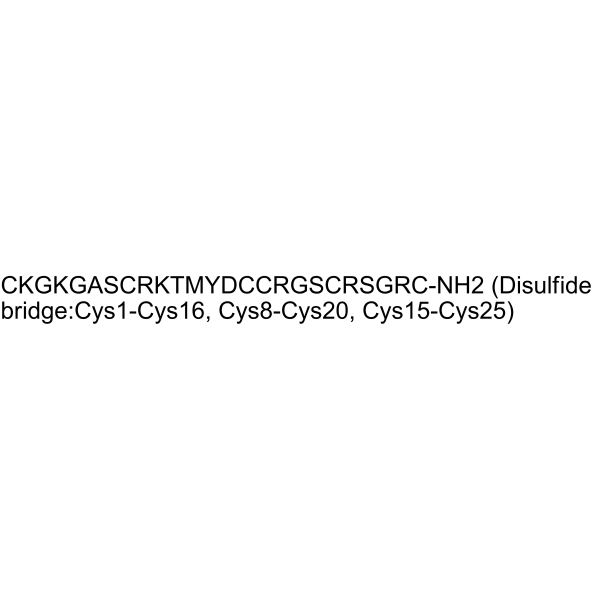
- HY-P5820
-
|
|
Calcium Channel
|
Neurological Disease
|
|
ω-Conotoxin Bu8 is a ω-conotoxin, which consists of 25 amino acid residues and three disulfide bridges. ω-Conotoxin Bu8 selectively and potently inhibits depolarization-activated Ba2+ currents mediated by rat CaV2.2 expressed in HEK293T cells (IC50= 89 nM) .
|
-

- HY-P5821
-
-
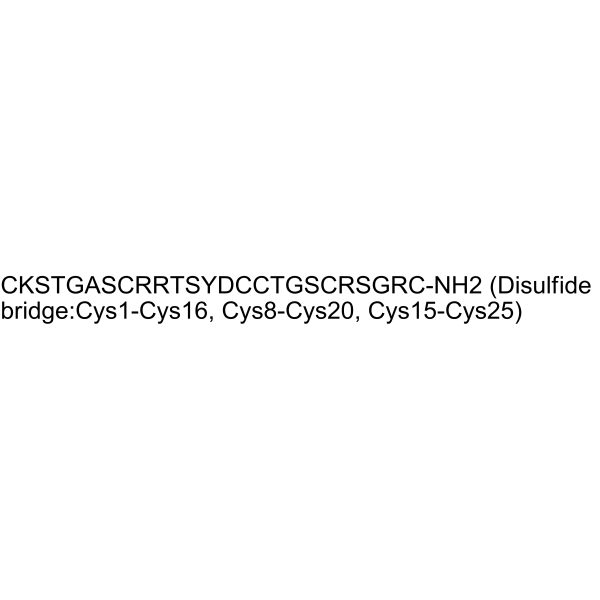
- HY-P5822
-
-
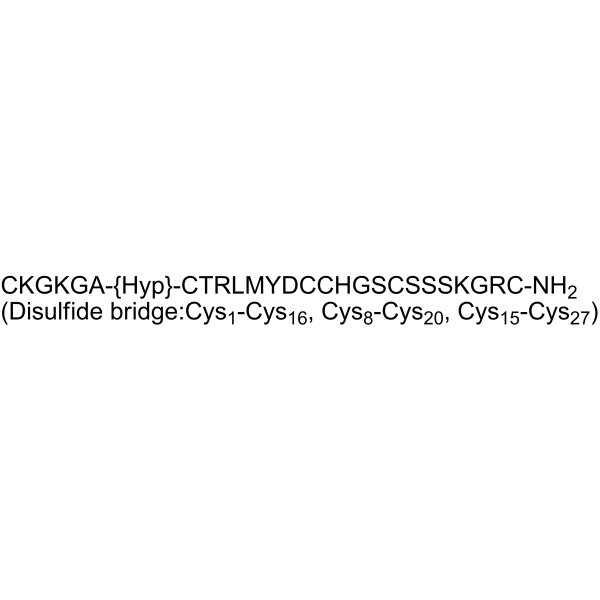
- HY-P5824
-
-

- HY-P5802
-
|
|
Calcium Channel
|
Neurological Disease
|
|
ω-Conotoxin FVIA is an N-type Ca 2+channel (Ca v 2.2)
inhibitor. ω-Conotoxin FVIA reduces mechanical and thermal pain abnormalities
in a rat model of caudal nerve injury. ω-Conotoxin FVIA can be used in the
study of highly effective pain relievers with low side effects
.
|
-

- HY-P5805
-
-

- HY-P5825
-
-

- HY-P5174
-
|
|
Sodium Channel
|
Neurological Disease
|
|
MitTx is a complex formed by MitTx-α and MitTx-β. MitTx is an ASIC1 channel activator with EC50 values of 9.4 and 23 nM for ASIC1a and ASIC1b isoforms, respectively. MitTx is highly selective for ASIC1 isoforms at neutral pH. Under acidic conditions, MitTx greatly enhances proton-evoked ASIC2a channel activation .
|
-

- HY-P2786A
-
-
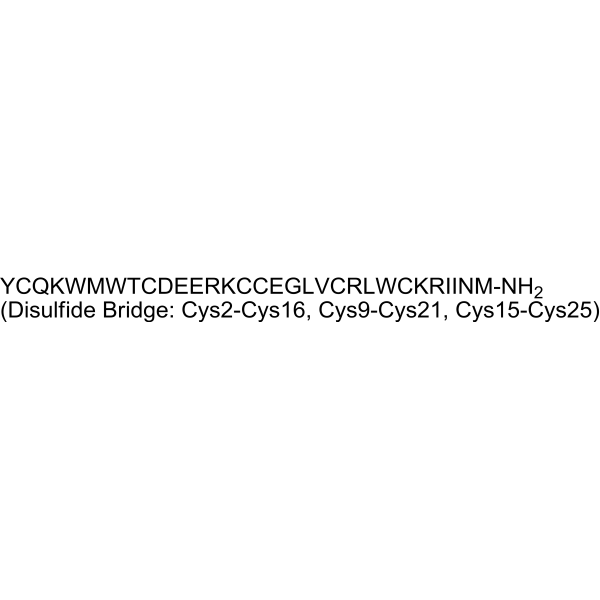
- HY-P5172
-
|
|
Sodium Channel
|
Neurological Disease
|
|
MitTx-alpha is a subunit of MitTx. MitTx is a potent, persistent, and selective agonist for acid-sensing ion channels (ASICs). MitTx is highly selective for the ASIC1 subtype at neutral pH; under more acidic conditions (pH<6.5), MitTx massively potentiates (>100-fold) proton-evoked activation of ASIC2a channels .
|
-

- HY-P0233
-
-

| Cat. No. |
Product Name |
Target |
Research Area |
-
- HY-P5917
-
|
Vaejovis mexicanus peptide 24
|
Potassium Channel
|
Others
|
|
Vm24-toxin is a toxin peptide that can be isolated from the Mexican scorpion Vaejovis mexicanus smithy. Vm24-toxin is an inhibitor of Kv1.3 potassium channel .
|
-
- HY-P5176
-
|
LtTx-1a
|
Peptides
|
Neurological Disease
|
|
Latartoxin-1a (LtTx-1a) is a peptide toxin can be isolated from L. tarabaevi. Latartoxin-1a is paralytic and lethal to insects and has membrane-bound activity .
|
-
- HY-P5818
-
-
- HY-P1426
-
|
|
Potassium Channel
|
Inflammation/Immunology
|
|
AmmTX3 is a peptide toxin that can be isolated from the venom of the scorpion Androctonus mauretanicus. AmmTX3 is specific blocker of Kv4 channel. AmmTX3 inhibits the A-type K + current (Ki: 131 nM) .
|
-
- HY-P5801
-
|
μ-TrTx-Phlo1a
|
Sodium Channel
|
Neurological Disease
|
|
Phlo1a (μ-TrTx-Phlo1a) is a peptide toxin contains 35-amino acid residues. Phlo1b is a selective Nav1.7 inhibitor. Phlo1a has a weak inhibitory effect on Nav1.2 and Nav1.5 .
|
-
- HY-137788
-
|
|
nAChR
|
Neurological Disease
|
|
α-Conotoxin GI has high affinity for nAChR.α-Conotoxin GI is a short peptide toxin that can be isolated from the venom of Conus geographus.α-Conotoxin GI has the similar activity with neuromuscular blocking agent .
|
-
- HY-P5800
-
|
μ-TrTx-Phlo1b
|
Sodium Channel
|
Neurological Disease
|
|
Phlo1b (μ-TrTx-Phlo1b) is a peptide toxin contains 35-amino acid residues. Phlo1b is a selective Nav1.7 inhibitor. Phlo1b has a weak inhibitory effect on Nav1.2 and Nav1.5 .
|
-
- HY-P5786
-
-
- HY-P5811
-
|
CcoTx1; β-TRTX-cm1a
|
Sodium Channel
|
Neurological Disease
|
|
Ceratotoxin-1 (CcoTx1), a peptide toxin, is an voltage-gated sodium channel subtypes inhibitor. Ceratotoxin-1 inhibits Nav1.1/β1, Nav1.2/β1, Nav1.4/β1, and Nav1.5/β1 with IC50 of 523 nM, 3 nM, 888 nM, and 323 nM, respectively. Ceratotoxin-1 also inhibits Nav1.8/β1 .
|
-
- HY-P1426A
-
|
|
Potassium Channel
|
Inflammation/Immunology
|
|
AmmTX3 TFA is a peptide toxin that can be isolated from the venom of the scorpion Androctonus mauretanicus. AmmTX3 TFA is specific blocker of Kv4 channel. AmmTX3 TFA inhibits the A-type K + current (Ki: 131 nM) .
|
-
- HY-P1280
-
|
|
Potassium Channel
|
Neurological Disease
|
|
Margatoxin, an alpha-KTx scorpion toxin, is a high affinity inhibitor of Kv1.3 (Kd=11.7 pM). Margatoxin inhibits the Kv1.2 (Kd=6.4 pM) and Kv1.1 (Kd=4.2 nM). Margatoxin, a 39 amino-acid-long peptide, is isolated from the venom of the scorpion Centruroides margaritatus and widely used in ion channel research .
|
-
- HY-P5164
-
|
|
Sodium Channel
|
Neurological Disease
|
|
GrTx1 is a peptide toxin originally isolated from the venom of the spider Grammostola rosea. GrTx1 blocks sodium channel, with IC50s of 0.63 µM, 0.23 µM, 0.77 µM, 1.29 µM, 0.63 µM and 0.37 µM for Nav1.1, Nav1.2, Nav1.3, Nav1.4, Nav1.6 and Nav1.7, repectively .GrTx1 can be used for neurological disease research .
|
-
- HY-P5175
-
|
|
mAChR
|
Neurological Disease
|
|
Muscarinic toxin 7 is a peptide toxin with selective and noncompetitive antagonism at the muscarinic M1 receptor .
|
-
- HY-P5942
-
-
- HY-P5943
-
-
- HY-P5854
-
|
|
Potassium Channel
|
Neurological Disease
|
|
Aa1 toxin, a neurotoxic peptide that can be obtained from the venom of Androctonus australis Garzoni, is a specific potassium channel blocker. Aa1 toxin can be used in the study of neurological diseases .
|
-
- HY-P5791
-
-
- HY-P10234
-
|
|
Sodium Channel
|
Others
|
|
Poneratoxin is a peptide toxin, which regulates the sodium currents in mammalian, and causes long-lasting pain .
|
-
- HY-P5944
-
|
|
Peptides
|
Others
|
|
Deamino-pterinotoxin-1 is a peptide toxin synthesized from the deamination of pterinotoxin-1 (HY-5943) .
|
-
- HY-P3682
-
|
|
Peptides
|
Neurological Disease
|
|
w-Conotoxin SVIB is a peptide toxin, it can be isolated from Conus venoms. w-Conotoxin SVIB inhibits twitch response with an IC50 value of 37 nM. w-Conotoxin SVIB induces respiratory distress and it can be lethal to mice at a high concentration .
|
-
- HY-P5177
-
-
- HY-P5140
-
|
|
Calcium Channel
|
Metabolic Disease
|
|
ω-Tbo-IT1 is a peptide toxin that can be isolated from the venom of Tibellus oblongus.ω-Tbo-IT1 is an inhibitor of insect calcium channel .
|
-
- HY-P3037
-
|
|
Calcium Channel
|
|
|
Imperatoxin A, a peptide toxin derived from the venom of the African scorpion Pandinus imperator, activator of Ca 2+-release channels/ryanodine receptors (RyRs)? enhances the influx of Ca 2+ from the sarcoplasmatic reticulum into the cell .
|
-
- HY-P5167
-
|
|
Peptides
|
Inflammation/Immunology
|
|
GsAF-1 is a peptide toxin containing three disulfide bonds. GsAF-1 can be isolated from the venom of the Chilean pink tarantula. GsAF-1 can be used for research of moderate-to-severe pain .
|
-
- HY-P5162
-
|
|
Sodium Channel
|
Inflammation/Immunology
|
|
Dc1a potently promotes opening of the German cockroach Nav channel (BgNav1). Dc1a is a toxin can be isolated from the desert bush spider Diguetia canities .
|
-
- HY-P5798
-
|
FAS-I
|
Cholinesterase (ChE)
|
Neurological Disease
|
|
Fasciculin-I is isolated from the mambas venom. Fasciculin-I exerts its toxic effects by inhibiting acetylcholinesterase (AChE). Fasciculin-I blocks α-neurotoxins of nicotinic acetylcholine receptors and cardiac toxins that interact with cell membranes .
|
-
- HY-P5179
-
|
HWTX-I
|
Calcium Channel
Sodium Channel
|
Neurological Disease
|
|
Huwentoxin I (HWTX-I) is a peptide toxin that inhibits voltage-gated sodium channels and N-type calcium channels. Huwentoxin I inhibits sodium channels in rat hippocampus and cockroach dorsal unpaired median (DUM) neurons with IC50 values of 66.1 and 4.80 nM, respectively .
|
-
- HY-P5852
-
|
Alpha-conotoxin EIIB
|
nAChR
|
Neurological Disease
|
|
α-Conotoxin EIIB (Alpha-conotoxin EIIB) is a toxin peptide that can be obtained from Conus ermineus. α-Conotoxin EIIB binds to nAChR (Ki=2.2 nM). α-Conotoxin EIIB can be used in the study of neurological diseases such as schizophrenia, drug addiction, Alzheimer's disease, and Parkinson's disease .
|
-
- HY-P5153
-
|
μ-TRTX-Tp1a
|
Sodium Channel
|
Neurological Disease
|
|
ProTx-III is a selective and potent inhibitor of voltage-gated sodium channel Nav1.7, with an IC50 of 2.1 nM. ProTx-III is a spider venom peptide isolated from the venom of the Peruvian green velvet tarantella. ProTx-III has a typical inhibitor cystine knot motif (ICK). ProTx-III is able to reverse the pain response. ProTx-III can be used to study diseases such as chronic pain, epilepsy, and arrhythmia .
|
-
- HY-P1280A
-
|
|
Potassium Channel
|
Neurological Disease
|
|
Margatoxin TFA, an alpha-KTx scorpion toxin, is a high affinity inhibitor of Kv1.3 (Kd=11.7 pM). Margatoxin TFA inhibits the Kv1.2 (Kd=6.4 pM) and Kv1.1 (Kd=4.2 nM). Margatoxin TFA, a 39 amino-acid-long peptide, is isolated from the venom of the scorpion Centruroides margaritatus and widely used in ion channel research .
|
-
- HY-P5165
-
|
|
Potassium Channel
|
Inflammation/Immunology
|
|
Maurotoxin is a 34-residue and four disulde-bridged toxin that can be isolated from the chactoid scorpion (Scorpio maurus). Maurotoxin inhibits the Shaker potassium channels (ShB) K + current with an IC50 of 2 nM .
|
-
- HY-P5156
-
|
|
Potassium Channel
|
Neurological Disease
|
|
BDS-I known as blood depressing substance, is a marine toxin which can be extracted from Anemonia sulcata. BDS-I is a specific inhibitor of Potassium Channel, targeting to Kv3.4. BDS-I inhibits Aβ1-42-induced enhancement of KV3.4 activity, caspase-3 activation, and abnormal nuclear morphology of NGF-differentiated PC-12 cells. BDS-I reverts the Aβ peptide-induced cell death .
|
-
- HY-P5807A
-
|
β-Mammal toxin Cn2 TFA
|
Sodium Channel
|
Neurological Disease
|
|
Cn2 toxin TFA (β-Mammal toxin Cn2 TFA) is a single-chain β-scorpion neurotoxic peptide that is the main toxin in scorpion venom. Cn2 toxin (TFA) specifically targets mammalian voltage-gated sodium channels (VGSC) Nav1.6 .
|
-
- HY-P5425
-
|
|
Peptides
|
Others
|
|
Tetanus Toxin (830–844) is a biological active peptide. (tetanus toxin-derived peptide TT830–844 CD4+ T-cell epitope. This promiscuous CD4+ T-cell epitope can bind to a wide range of HLA–DRB molecules and is thus expected to activate CD4+ T-cell responses in a large part of the human population)
|
-
- HY-P4211
-
|
|
Bacterial
|
Infection
|
|
PSM-β is a active peptide , which can be isolated from Staphylococcus epidermidis. PSM-β is an analog of staphylococcal toxins, as well as a termed phenol-soluble modulin. PSM-β has bacteriostatic and poorly hemolytic properties .
|
-
- HY-P3064
-
|
Leiurotoxin I
|
Potassium Channel
|
Neurological Disease
|
|
Scyllatoxin (Leiurotoxin I) is a peptide toxin, it can be isolated from the venom of the scorpion (Leiurus quinquestriatus hebraeus). Scyllatoxin is a blocker of small-conductance KCa (SK) channel. Scyllatoxin enhances both norepinephrine (NE) and epinephrine (Epi) release in vivo .
|
-
- HY-P1105
-
|
|
Chloride Channel
|
Neurological Disease
|
|
GaTx2 is a seletive and a high affinity inhibitor of ClC-2 channels with a voltage-dependent apparent KD of ∼20 pM. GaTx2 is a peptide toxin inhibitor from Leiurus quinquestriatus hebraeus venom. GaTx2 is useful in determining the role and the membrane localization of ClC-2 in specific cell types .
|
-
- HY-P5182A
-
|
|
Potassium Channel
|
Inflammation/Immunology
|
|
HsTX1 (TFA) toxin, from the scorpion Heterometrus spinnifer, is a 34-residue, C-terminally amidated peptide cross-linked by four disulfide bridges. HsTX1 (TFA) is an the inhibitor of potassium channel, with IC50 for Kv1.3 of 12 pM and inhibits TEM cell activation and attenuates inflammation in autoimmunity .
|
-
- HY-P2358
-
|
|
Toll-like Receptor (TLR)
|
Inflammation/Immunology
|
|
PSMα3 is a peptide for manipulating DCs to become tolerogenic for DC vaccination strategies. PSMα3 penetrates and modulates human monocyte-derived DCs by altering the TLR2- or TLR4-induced maturation, inhibiting pro- and anti-inflammatory cytokine production and reducing antigen uptake. PSMα3 is an important toxin released by the most virulent strains of methicillin-resistant Staphylococcus aureus (MRSA) .
|
-
- HY-P3444
-
|
PECAM-1
|
SHP2
Bacterial
|
Metabolic Disease
Inflammation/Immunology
|
|
CD31 (PECAM-1) is platelet endothelial cell adhesion molecule-1, serves as the endothelial cell-specific receptor of clostridium perfringens b-Toxin (CPB). CD31 is also an ER-MP12 antigen, acts as a linker between mechanical stress, metabolism and inflammation. CD31 peptide is able to sustain phosphorylation of the CD31 ITIM686 and of SHP2 and to inhibit TCR-induced T-cell activation - .
|
-
- HY-P3718
-
-
- HY-P2358A
-
|
|
Peptides
|
Inflammation/Immunology
|
|
PSMα3 TFA is a peptide for manipulating DCs to become tolerogenic for DC vaccination strategies. PSMα3 TFA penetrates and modulates human monocyte-derived DCs by altering the TLR2- or TLR4-induced maturation, inhibiting pro- and anti-inflammatory cytokine production and reducing antigen uptake. PSMα3 TFA is an important toxin released by the most virulent strains of methicillin-resistant Staphylococcus aureus (MRSA) .
|
-
- HY-P3444A
-
|
PECAM-1 TFA
|
SHP2
Bacterial
|
Metabolic Disease
Inflammation/Immunology
|
|
CD31 (PECAM-1) TFA is platelet endothelial cell adhesion molecule-1, serves as the endothelial cell-specific receptor of clostridium perfringens b-Toxin (CPB). CD31 TFA is also an ER-MP12 antigen, acts as a linker between mechanical stress, metabolism and inflammation. CD31 TFA peptide is able to sustain phosphorylation of the CD31 ITIM686 and of SHP2 and to inhibit TCR-induced T-cell activation - .
|
-
- HY-P1117
-
|
|
Formyl Peptide Receptor (FPR)
Calcium Channel
|
Neurological Disease
Inflammation/Immunology
|
|
MMK1 is a potent and selective human formyl peptide receptor like-1 (FPRL-1/FPR2) agonist with EC50s of <2 nM and >10000 nM for FPRL-1 and FPR1, respectively. MMK1 is a potent chemotactic and calcium-mobilizing agonist. MMK1 potently activates phagocytic leukocytes and enhances Pertussis Toxin (HY-112779)-sensitive production by human monocytes of proinflammatory cytokines IL-1b and IL-6. MMK1 exerts anxiolytic-like activity .
|
-
- HY-P1117A
-
|
|
Formyl Peptide Receptor (FPR)
Calcium Channel
|
Neurological Disease
Inflammation/Immunology
|
|
MMK1 TFA is a potent and selective human formyl peptide receptor like-1 (FPRL-1/FPR2) agonist with EC50s of <2 nM and >10000 nM for FPRL-1 and FPR1, respectively. MMK1 TFA is a potent chemotactic and calcium-mobilizing agonist. MMK1 TFA potently activates phagocytic leukocytes and enhances Pertussis Toxin (HY-112779)-sensitive production by human monocytes of proinflammatory cytokines IL-1b and IL-6. MMK1 TFA exerts anxiolytic-like activity .
|
-
- HY-P0256
-
Apamin
3 Publications Verification
Apamine
|
Potassium Channel
|
Neurological Disease
Inflammation/Immunology
|
|
Apamin (Apamine) is an 18 amino acid peptide neurotoxin found in apitoxin (bee venom), is known as a specifically selective blocker of Ca 2+-activated K + (SK) channels and exhibits anti-inflammatory and anti-fibrotic activity .
|
-
- HY-P0173A
-
|
|
Chloride Channel
|
Cancer
|
|
Chlorotoxin is a 36 amino-acid peptide from the venom of the Israeli scorpion Leiurus quinquestriatus with anticancer activity. Chlorotoxin is a chloride channel blocker.
|
-
- HY-P1411
-
|
PcTx1; Psalmopoeus cambridgei toxin-1
|
Sodium Channel
Apoptosis
|
Neurological Disease
Cancer
|
|
Psalmotoxin 1 (PcTx1) is a protein toxin that can bind at subunit-subunit interfaces of acid-sensing ion channel 1a (ASIC1a). Psalmotoxin 1 is a potent and slective ASIC1a inhibitor (IC50: 0.9 nM) by increasing the apparent affinity for H + of ASIC1a. Psalmotoxin 1 can induce cell apoptosis, also inhibits cell migration, proferliration and invasion of cancer cells. Psalmotoxin 1 can be used in the research of cancers, or neurological disease .
|
-
- HY-P0173B
-
|
|
Chloride Channel
|
Cancer
|
|
Chlorotoxin TFA is a peptide isolated from the venom of the scorpion Leiurus quinquestriatus, acts as a chloride channel blocker . Anti-cancer activity .
|
-
- HY-P1410A
-
GsMTx4 TFA
Maximum Cited Publications
28 Publications Verification
|
TRP Channel
Piezo Channel
|
Cardiovascular Disease
Neurological Disease
Inflammation/Immunology
|
|
GsMTx4 TFA is a spider venom peptide that selectively inhibits cationic-permeable mechanosensitive channels (MSCs) belonging to the Piezo and TRP channel families. GsMTx4 TFA also blocks cation-selective stretch-activated channels (SACs) , attenuates lysophosphatidylcholine (LPC)-induced astrocyte toxicity and microglial reactivity. GsMTx4 TFA is an important pharmacological tool for identifying the role of these excitatory MSCs in normal physiology and pathology .
|
- HY-P1268A
-
|
|
nAChR
|
Neurological Disease
|
|
α-Conotoxin PIA TFA is a nicotinic acetylcholine receptor (nAChR) antagonist that targets nAChR subtypes containing α6 and α3 subunits. α-Conotoxin PIA has the potential for the research of Parkinson’s disease, and schizophrenia 。
|
- HY-P1346
-
|
|
Sodium Channel
|
Neurological Disease
Inflammation/Immunology
|
|
APETx2, a sea anemone peptide from Anthopleura elegantissima, is a selective and reversible ASIC3 inhibitor, with an IC50 of 63 nM. APETx2 directly inhibits the ASIC3 channel by acting at its external side. APETx2 could reverses acid‐induced and inflammatory pain .
|
- HY-P0189A
-
- HY-P1078
-
|
|
Calcium Channel
|
Neurological Disease
|
|
Huwentoxin XVI, an analgesic, is a highly reversible and selective mammalian N-type calcium channel (IC50 of ~60 nM) antagonist from Chinese tarantula Ornithoctonus huwena. Huwentoxin XVI has no effect on voltagegated T-type calcium channels, potassium channels or sodium channels .
|
- HY-P1189
-
|
|
Integrin
|
Metabolic Disease
Inflammation/Immunology
|
|
Echistatin, the smallest active RGD protein belonging to the family of disintegrins that are derived from snake venoms, is a potent inhibitor of platelet aggregation. Echistatin is a potent inhibitor of bone resorption in culture. Echistatin is a potent antagonist of αIIbβ3, αvβ3 and α5β1 .
|
- HY-P1293
-
|
|
iGluR
|
Neurological Disease
|
|
Conantokin G, a 17-amino-acid peptide, is a potent, selective and competitive antagonist of N-methyl-D-aspartate (NMDA) receptors. Conantokin G inhibits NMDA-evoked currents in murine cortical neurons with an IC50 of 480 nM. Conantokin G has neuroprotective properties .
|
- HY-P1282
-
- HY-P1220A
-
|
|
Sodium Channel
|
Neurological Disease
|
|
Huwentoxin-IV TFA is a potent and selective sodium channel blocker, inhibits neuronal Nav1.7, Nav1.2, Nav1.3 and Nav1.4 with IC50s of 26, 150, 338 and 400 nM, respectively. Huwentoxin-IV TFA preferentially blocks peripheral nerve subtype Nav1.7 by binding neurotoxin receptor site 4. Huwentoxin-IV TFA has analgesic effects on animal models of inflammatory and neuropathic pain .
|
- HY-P1441
-
|
|
Sodium Channel
|
Others
|
|
Mambalgin-1 is a toxin isolated from black mamba venom. Mambalgin-1 is a disulfide-rich polypeptide consisting of 57 amino acids and belongs to the family of three-finger toxins. Mambalgin-1 can bind to and stabilize ASICs (acid-sensing ion channels) in a physiologically relevant closed-channel conformation .
|
- HY-P1424
-
|
|
Potassium Channel
|
Neurological Disease
|
|
Lei-Dab7 is a potent and selective SK2 (KCa2.2) channels blocker with a Kd of 3.8 nM. Lei-Dab7 shows low or no activity on KCa1, KCa3, Kv and Kir2.1 channels .
|
- HY-P1410
-
GsMTx4
Maximum Cited Publications
28 Publications Verification
|
TRP Channel
Piezo Channel
|
Cardiovascular Disease
Neurological Disease
Inflammation/Immunology
|
|
GsMTx4 is a spider venom peptide that selectively inhibits cationic-permeable mechanosensitive channels (MSCs) belonging to the Piezo and TRP channel families. GsMTx4 also blocks cation-selective stretch-activated channels (SACs) , attenuates lysophosphatidylcholine (LPC)-induced astrocyte toxicity and microglial reactivity. GsMTx4 is an important pharmacological tool for identifying the role of these excitatory MSCs in normal physiology and pathology .
|
- HY-P1440
-
- HY-P1221
-
|
|
Sodium Channel
|
Neurological Disease
|
|
ProTx II is a selective blocker of Nav1.7 sodium channels with an IC50 of 0.3 nM, and is at least 100-fold selective for Nav1.7 over other sodium channel subtypes. ProTx-II inhibits sodium channels by decreasing channel conductance and shifting activation to more positive potentials and blocks action potential propagation in nociceptors .
|
- HY-P1701
-
|
|
Opioid Receptor
|
Cardiovascular Disease
Neurological Disease
|
|
Morphiceptin is a potent and specific agonist for morphine (μ) receptors. Morphiceptin, as a synthetic peptide, is the amide of a fragment of the milk protein β-casein. Morphiceptin has morphinelike activities and is highly specific for morphine (μ) receptors but not for enkephalin (⸹) receptors .
|
- HY-P1427
-
|
|
Potassium Channel
|
Neurological Disease
|
|
Guangxitoxin 1E is a potent and selective blocker of KV2.1 and KV2.2 channels. Guangxitoxin 1E inhibits KV2 with an IC50 of 1-3 nM. KV2 channels underlie delayed-rectifier potassium currents in various neurons .
|
- HY-P1219
-
|
β-TRTX-Cj1α
|
Sodium Channel
|
Neurological Disease
|
|
Jingzhaotoxin-III is a potent and selective blocker of Nav1.5 channels, with an IC50 of 348 nM, and shows no effect on other sodium channel isoforms. Jingzhaotoxin-III can selectively inhibit the activation of cardiac sodium channel but not neuronal subtypes, and hopefully represents an important ligand for discriminating cardiac VGSC subtype .
|
- HY-P1409
-
|
|
Potassium Channel
|
Inflammation/Immunology
|
|
ADWX 1 is a new peptide inhibitor that is potent and selective for Kv1.3 with an IC50 value of 1.89 pM. ADWX 1 inhibits Kv1.3 channel activity specifically to inhibit both the initial calcium signaling and NF-κB activation. ADWX 1 ameliorates the disease in rats of experimental autoimmune encephalomyelitis (EAE) models. ADWX 1 can be used to study T cell-mediated autoimmune diseases .
|
- HY-P5158
-
|
|
Adrenergic Receptor
|
Others
|
|
Conopeptide rho-TIA is a peptide derived from the venom contained in the predatory sea snail Conus tulipa, has highly selective and noncompetitive inhibitor at human α1B-Adrenergic Receptor. Conopeptide rho-TIA acts a competitive inhibitor at human α1A-Adrenergic Receptor and α1D-Adrenergic Receptor. Conopeptide rho-TIA binds to each subtype and may provide useful information for the development of novel α1-Adrenergic Receptor subtype-selective drugs .
|
- HY-P1330
-
|
|
P2X Receptor
|
Inflammation/Immunology
|
|
Purotoxin 1 is a P2X3 receptor inhibitor. Purotoxin 1 shows antinociceptive properties in animal models of inflammatory pain. Purotoxin 1 can be isolated from the venom of the wolf spider Geolycosa sp .
|
- HY-P1408
-
|
|
Integrin
|
Cancer
|
|
Obtustatin is a non-RGD disintegrin of 41 residues. Obtustatin can be isolated from Vipera lebetina obtusa venom. Obtustatin is a potent and selective inhibitor of the adhesion of integrin α1β1 to collagen IV. Obtustatin inhibits angiogenesis, and can be used for research of cancer .
|
- HY-P1442
-
|
|
Adrenergic Receptor
|
Cancer
|
|
AdTx1 is a selective α1A-adrenoceptor antagonist (Ki: 0.35 nM). AdTx1 can be used for research of benign prostatic hyperplasia .
|
- HY-P1443
-
|
|
Sodium Channel
|
Cancer
|
|
OD1 is a scorpion α-toxin that can be isolated from the venom of the Iranian yellow scorpion (Odonthobuthus doriae. OD1 is a modulator of mammalian Nav1.7 (EC50: 4.5 nM) .
|
- HY-P1604
-
|
|
Sodium Channel
|
Inflammation/Immunology
|
|
ATX-II is a specific Na + channel Modulator toxin that can be isolated from the venom of sea anemone (Anemonia sulcata). ATX-II causes delayed inactivation of the Na +
|
- HY-P1952
-
|
|
Sodium Channel
|
Inflammation/Immunology
|
|
μ-Conotoxin-CnIIIC is a 22-residue conopeptide that can be isolated from Conus consors. μ-Conotoxin-CnIIIC is a potent and persistent blocker of NaV1.4 channel. μ-Conotoxin-CnIIIC has analgesic, anaesthetic and myorelaxant properties .
|
- HY-P2700
-
|
|
Sodium Channel
|
Neurological Disease
|
|
μ-Conotoxin GIIIB is a 22-residue polypeptide that can be isolated from the venom of piscivorous cone snail Conus geographus. μ-Conotoxin GIIIB is a NaV1.4 channel inhibitor. μ-Conotoxin GIIIB blocks muscle cell's contraction .
|
- HY-P3071
-
|
|
Potassium Channel
|
Inflammation/Immunology
|
|
ShK toxin blocks voltage-dependent potassium channel (Kv1.3 channel). ShK toxin can be isolated from the whole body extract of the Caribbean sea anemone (Stichodactylu helianthus). ShK toxin competes with dendrotoxin I and α-dendrotoxin for binding to synaptosomal membranes of rat brain, facilitates acetylcholine release. ShK toxin suppresses K+ currents in cultured rat dorsal root ganglion neurons. ShK toxin also inhibits T lymphocyte proliferation .
|
- HY-P5142
-
|
ω-ACTX-Hv1; ω-Atracotoxin-HV1
|
Calcium Channel
|
Neurological Disease
|
|
ω-Hexatoxin-Hv1a is a neurotoxin that can be isolated from the venom spider (Hadronyche versuta).ω-Hexatoxin-Hv1a blocks voltage-gated calcium channels .
|
- HY-P5159
-
|
|
Sodium Channel
|
Inflammation/Immunology
|
|
Crotamine is a Na + channel modulator. Crotamine is a 42 amino acid toxin cross-linked by three disulfide bridges. Crotamine has analgesic activity. Crotamine also interacts with lipid membranes and shows myonecrotic activity. Crotamine can be isolated from Crotalus durissus terrificus venom .
|
- HY-P5146
-
- HY-P5141
-
|
|
Sodium Channel
|
Inflammation/Immunology
|
|
μ-Conotoxin KIIIA is an analgesic μ-conotoxin that can be isolated from Conus kinoshitai. μ-Conotoxin KIIIA blocks mammalian neuronal voltage-gated sodium channels (VGSCs) (Nav1.2).μ-Conotoxin KIIIA can be used for research of pain .
|
- HY-P5143
-
|
|
Calcium Channel
|
Inflammation/Immunology
|
|
ω-Conotoxin SO3 is a blocker of N-type voltage-sensitive calcium channel. ω-Conotoxin SO3 is an analgesicω-conotoxin that can be isolated from the venom of C. striatus .
|
- HY-P5144
-
- HY-P5145
-
- HY-P5160
-
|
PhlTx1
|
Sodium Channel
|
Inflammation/Immunology
|
|
Phlotoxin-1 (PhlTx1) is a 34-amino acid and 3-disulfide bridge peptide. Phlotoxin-1 can be isolated from Phlogiellus genus spider. Phlotoxin-1 is an antinociceptive agent by inhibiting NaV1.7 channel .
|
- HY-P5154
-
|
|
Potassium Channel
|
Neurological Disease
|
|
Tamapin is a venom peptide, targeting to small conductance Ca(2+)-activated K(+) (SK) channels. Tamapin is a selctive blocker of SK2 (Potassium Channel). Tamapin inhibits SK channel-mediated currents in pyramidal neurons of the hippocampus. Tamapin can be isolated from the Indian red scorpion (Mesobuthus tamulus) .
|
- HY-P5147
-
|
|
nAChR
|
Neurological Disease
|
|
α-Conotoxin GID is a paralytic peptide neurotoxin and a selective antagonist of nAChR, with IC50s of 5 nM (α7), 3 nM (α3β2), 150 nM (α4β2), respectively. α-Conotoxin GID is small disulfide-rich peptide, with potential to inhibit chronic pain. α-Conotoxin GID contains a C-terminal carboxylate, thus substitution with a C-terminal carboxamide results in loss of α4β2 nAChR. α-Conotoxin GID can be isolated from the Conus species .
|
- HY-P5149
-
|
αC-PrXA
|
nAChR
|
Neurological Disease
|
|
αC-Conotoxin PrXA is a paralytic peptide neurotoxin and a competitive nAChR antagonist, with IC50s of 1.8 nM (α1β1εδ, adult) and 3.0 nM (α1β1γδ, fetal), respectively. αC-Conotoxin PrXA competes with α-bungarotoxin at the α/δ and α/γ subunit interfaces of the nAChR, shows high specificity against neuromuscular nAChR .
|
- HY-P5148
-
|
|
nAChR
|
Neurological Disease
|
|
α-Conotoxin BuIA is a paralytic peptide neurotoxin and a competitive nAChR antagonist, with IC50s of 0.258 nM (α6/α3β2), 1.54 nM (α6/α3β4), 5.72 nM (α3β2), respectively. α-Conotoxin BuIA can be used to distinguish nAChRs containing β2- and β4-subunit, respectively. α-Conotoxin BuIA distinguishes among αxβ2 nAChRs with a rank order potency of α6>α3>α2>α4 .
|
- HY-P5151
-
|
|
Peptides
|
Others
|
|
LiTx3 is a lethal and cysteine-rich peptide. LiTx3 can be isolated from L. intermedia crude venom. LiTx3 induces flaccid paralysis in Spodoptera frugiperda larvae .
|
- HY-P5150
-
|
|
Peptides
|
Neurological Disease
|
|
alpha-Cobratoxin is a neurotoxin, which can be isolated from the venom of the Thailand cobra. alpha-Cobratoxin exhibits neuromodulatory, antiviral, and analgesic activity. alpha-Cobratoxin also shows potent immunosuppressive activity for acute and chronic multiple sclerosis. alpha-Cobratoxin is further on research in adrenomyeloneuropathy .
|
- HY-P5152
-
|
|
Sodium Channel
|
Neurological Disease
|
|
Scorpion toxin Tf2 is a β-scorpion toxin, which is firstly identified in the venom of the Brazilian scorpion Tityus fasciolatus. Scorpion toxin Tf2 is a Nav1.3 activator, which is a neuronal voltage-gated sodium (Nav) subtype implicated in epilepsy and nociception. Scorpion toxin Tf2 enhances hNav1.3 activation voltage and opens the channel at resting membrane potentials .
|
- HY-P5155
-
|
|
Potassium Channel
|
Neurological Disease
|
|
Stromatoxin 1 is an inhibitor of Potassium Channel, a peptide which can be isolated from tarantulas. Stromatoxin 1 selectively inhibits K(V)2.1, K(V)2.2, K(V)4.2, and K(V)2.1/9.3 channels. K(V)2.1 and K(V)2.2, but not K(V)4.2, channel subunits play a key role in opposing both myogenic and neurogenic urinary bladder smooth muscle (UBSM) contractions in rats .
|
- HY-P5157
-
|
|
Potassium Channel
|
Neurological Disease
|
|
BmP02 is a selective Kv1.3 channel blocker and a highly-selective Kv4.2 modulator, which can be isolated from Chinese scorpion (Buthus martensi Karsch) venom. BmP02 also delays the inactivation of Kv4.2 in HEK293T cells, with an EC50 value of ~850 nM. BmP02 inhibits the transient outward potassium currents (Ito) in ventricular muscle cells .
|
- HY-P5184
-
|
HNTX-IV
|
Sodium Channel
|
Neurological Disease
|
|
Hainantoxin-IV is a specific antagonist of Sodium Channel, targeting to tetrodotoxin-sensitive (TTX-S) voltage-gated sodium channels. His28 and Lys32 are the key resiudes of Hainantoxin-IV for binding with target, while Hainantoxin-IV adopts an inhibitor cystine knot motif .
|
- HY-P5163
-
|
|
Peptides
|
Inflammation/Immunology
|
|
NMB-1 is a conopeptide analogue. NMB-1 selectively inhibits sustained mechanically activated currents in sensory neurons (IC50: 1 μM). NMB-1 inhibits mechanical pain. NMB-1 can be used for research of hearing and pressure-evoked pain .
|
- HY-P5166
-
|
|
Peptides
|
Others
|
|
Lys-Conopressin-G, a vasotocin-like peptide, can be isolated from the venom of the worm-hunting snail (conus imperialis) .
|
- HY-P5183
-
|
|
Sodium Channel
|
Neurological Disease
|
|
Hm1a is a disulfide-rich spider-venom peptide, and a NaV1.1 activator. Hm1a restores the function of inhibitory interneurons in Dravet syndrome (DS) mouse model .
|
- HY-P3055
-
|
DTX-I
|
Potassium Channel
|
Neurological Disease
Cancer
|
|
Dendrotoxin-I is a potent K + channels blocker and targets voltage-gated potassium channel subunits KV1.1 and KV1.2. Dendrotoxin-I is a neurotoxin isolated from thevenom of Dendroaspis snakes .
|
- HY-105168
-
|
|
Endothelin Receptor
|
Cardiovascular Disease
|
|
TAK 044 is an antagonist of Endothelin Receptor. TAK 044 strongly inhibits ET-induced deterioration in various animal models. TAK 044 can be used in study ET-related diseases such as acute myocardial infarction,acute renal failure, acute hepatic malfunction, and subarachnoid hemorrhage .
|
- HY-110183
-
|
|
Peptides
|
Cardiovascular Disease
|
|
Angiotensin A is a renin–angiotensin system (RAS) peptide that causes a vasoconstrictive effect dependent on AT1 receptors. Angiotensin A elicits pressor and renal vasoconstrictor responses in normotensive and hypertensive rats .
|
- HY-P1264F
-
|
|
nAChR
|
Neurological Disease
|
|
FITC-α-Bungarotoxin is the FITC labelled α-Bungarotoxin (HY-P1264). α-Bungarotoxin is a competitive antagonist at nicotinic acetylcholine receptors (nAChRs) .
|
- HY-P1264F1
-
|
|
nAChR
|
Neurological Disease
|
|
Biotin-α-Bungarotoxin is the Biotin labelled α-Bungarotoxin (HY-P1264). α-Bungarotoxin is a competitive antagonist at nicotinic acetylcholine receptors (nAChRs) .
|
- HY-P1285
-
|
Con-R
|
iGluR
|
Neurological Disease
|
|
Conantokin R (Con-R) is an NMDA receptor peptide antagonist with an IC50 of 93 nM. Conantokin R binds Zn 2+ and Mg 2+ with Kds of 0.15 μM and 6.5 μM, respectively. Conantokin R shows anticonvulsant activity .
|
- HY-P2699
-
|
GrTx; ω-GsTx SIA
|
Calcium Channel
|
Neurological Disease
|
|
ω-Grammotoxin SIA (GrTx) is P/Q and N-type voltage-gated Calcium channels inhibitor. ω-Grammotoxin SIA is also a protein toxin that can be obtained from spider venom. ω-Grammotoxin SIA has the potential to study neurological diseases as well as cardiovascular diseases .
|
- HY-P5849
-
|
αA-OIVA
|
nAChR
|
Neurological Disease
|
|
αA-Conotoxin OIVA (αA-OIVA) is a selective nAChR antagonist with an IC50 of 56 nM against mammalian fetal muscle nAChR. αA-Conotoxin OIVA is a peptide that can be derived from conotoxin. αA-Conotoxin OIVA paralyzes muscles .
|
- HY-P5851
-
|
|
Biochemical Assay Reagents
|
Neurological Disease
|
|
AaHI is a neurotoxin that can be obtained from the venom of the North African scorpion Androctonus australis hector. AaHI can be used as a tool for the development of active substances with toxin-neutralizing capabilities .
|
- HY-P5863
-
|
Mamb-2
|
Sodium Channel
|
Neurological Disease
|
|
Mambalgin-2 (Mamb-2) is an acid-sensitive ion channels (ASICs) inhibitor and a venom peptide. Mambalgin-2 can be obtained from the venom of the African black mamba. Mambalgin-2 can be used in the study of pain and neurological diseases .
|
- HY-P5782
-
|
|
Sodium Channel
|
Neurological Disease
|
|
δ-Theraphotoxin-Hm1a toxin is a selective Nav1.1 activator. δ-Theraphotoxin-Hm1a toxin elicits pain and touch sensitivity. δ-Theraphotoxin-Hm1a toxin can be used for the research of irritable bowel syndrome .
|
- HY-P5795
-
|
|
Sodium Channel
Potassium Channel
|
Neurological Disease
|
|
GsAF-I is a potent Nav and hERG1 channels blocker with IC50s of 0.36, 0.6, 1.28, 0.33, 1.2, 0.04 and 4.8 μM against Nav1.1, Nav1.2, Nav1.3, Nav1.4, Nav1.6, Nav1.7 and hERG1, respectively .
|
- HY-P5796
-
|
|
Calcium Channel
|
Neurological Disease
|
|
FS-2 is a potent and specific L-type CaV channel inhibitor. FS-2 inhibits high K + or glucose induced L-type Ca 2+ influx in RIN beta cells .
|
- HY-P5804
-
|
|
Calcium Channel
|
Neurological Disease
|
|
ω-Conotoxin CVIF is a selective Cav2.2 channel inhibitor with an IC50 of 34.3 nM in rat isolated DRG neurons. ω-Conotoxin CVIF block of Cav2.2 channels is weakly reversible .
|
- HY-P5809
-
- HY-P5810
-
|
CcoTx2; β-TRTX-cm1b
|
Sodium Channel
|
Neurological Disease
|
|
Ceratotoxin-2 (CcoTx2) is a voltage-gated sodium channel blocker with IC50s of 8 nM and 88 nM against Nav1.2/β1 and Nav1.3/β1, respectively .
|
- HY-P5823
-
|
|
nAChR
|
Neurological Disease
|
|
Azemiopsin is a potent nicotinic acetylcholine receptor (nAChR) inhibitor with IC50s of 0.18 μM and 22 μM against T. californica nAChR and human α7 nAChR, respectively. Azemiopsin blocks acetylcholine-induced currents in Xenopus oocytes heterologously expressing human muscle-type nAChR .
|
- HY-P5828
-
- HY-P5833
-
|
κ-Bgt
|
nAChR
|
Neurological Disease
|
|
κ-Bungarotoxin (κ-Bgt) is a potent, selective, and slowly reversible antagonist of α3β2 neuronal nicotinic acetylcholine receptors with an IC50 of 2.30 nM .
|
- HY-P5835
-
|
|
Potassium Channel
|
Neurological Disease
|
|
δ-Dendrotoxin is a K + channel blocker that can be obtained from the venom of the black mamba snake. δ-Dendrotoxin can be used in the study of neurological diseases .
|
- HY-P5839
-
|
|
nAChR
|
Neurological Disease
|
|
α-Conotoxin MrIC is an α7nAChR biased agonist. α-Conotoxin MrIC exclusively activates α7nAChR regulated by type II positive allosteric modulators, including PNU120596. α-Conotoxin MrIC can be used to study neurological diseases and also to probe the pharmacological properties of α7nAChR .
|
- HY-P5841
-
|
|
Liposome
|
Neurological Disease
|
|
α-Conotoxin LtIA is an α3β2 nAChR blocker (IC50=9.8 nM), that can be obtained from Conus litteratus venom. Alpha-Conotoxin LtIA can be used in the study of neurological diseases (such as Parkinson's disease, pain) .
|
- HY-P5844
-
|
|
nAChR
|
Neurological Disease
|
|
α-Conotoxin AuIA is a potent and selective α3β4 n-nAChR inhibitor. α-Conotoxin AuIA is a α-conotoxin that can be isolated from Conus aulicus .
|
- HY-P5845
-
|
α-RgIA
|
nAChR
|
Neurological Disease
|
|
α-Conotoxin RgIA (α-RgIA) is a specific α9α10 nAChR antagonist. α-Conotoxin RgIA can be obtained from Conus regius venom. α-Conotoxin RgIA can be used in the study of neurological diseases .
|
- HY-P5846
-
|
MT3
|
mAChR
Adrenergic Receptor
|
Neurological Disease
|
|
Muscarinic toxin 3 (MT3) is a potent and non-competitive mAChR and adrenoceptors antagonist with pIC50s of 6.71, 8.79, 8.86, 7.57, 8.13, 8.49, <6.5, 7.29 against M1, M4, α1A, α1B, α1D,α2A,α2B and α2C receptors, respectively. Muscarinic toxin 3 displays prominent adrenoceptor activity .
|
- HY-P5847
-
- HY-P5848
-
|
|
nAChR
|
Neurological Disease
|
|
αO-Conotoxin GeXIVA is a potent α9α10 nAChR antagonist with an IC50 of 12 nM against rat α9α10. αO-Conotoxin GeXIVA shows analgesic in animal models of pain .
|
- HY-P5850
-
|
|
nAChR
|
Neurological Disease
|
|
α-Conotoxin Bt1.8 is a potent α6/α3β2β3 and α3β2 nAChRs inhibitor with IC50s of 2.1 nM and 9.4 nM against rat α6/α3β2β3 and α3β2, respectively .
|
- HY-P5853
-
|
|
Potassium Channel
|
Inflammation/Immunology
|
|
Aam-KTX is a Kv channel inhibitor with IC50 values of 1.1 nM and >750 nM for Kv1.3 and Kv1.1, respectively. Aam-KTX is a toxic peptide obtained from the venom of the scorpion Mesobuthus eupeus. Aam-KTX has potential in autoimmune diseases research .
|
- HY-P5855
-
|
|
Sodium Channel
|
Neurological Disease
|
|
μ-Conotoxin SxIIIC is an irreversible NaV channel inhibitor that can be obtained from the Conus striolatus. μ-Conotoxin SxIIIC can be used in the study of neurological diseases such as chronic pain .
|
- HY-P5856
-
|
|
nAChR
|
Neurological Disease
|
|
αA-Conotoxin PIVA is a selective mouse musclenAChR inhibitor with IC50 for adult and fetal mouse musclenAChR sub> values are 2.3 nM and 22 nM respectively. αA-Conotoxin PIVA can be used in the study of neurological diseases.
|
- HY-P5857
-
|
Micrurotoxin 2
|
GABA Receptor
|
Neurological Disease
|
|
MmTx2 toxin is a GABAA receptor modulator that enhances GABAA receptor sensitivity to agonists. MmTx2 toxin can be obtained from venom of coral snake. MmTx2 toxin can be used in the study of neurological diseases such as epilepsy, schizophrenia and chronic pain .
|
- HY-P5858
-
|
|
Sodium Channel
|
Neurological Disease
|
|
μ-Conotoxin SIIIA is a tetrodotoxin (TTX)-resistant sodium channel blocker. μ-Conotoxin SIIIA is a toxic peptide that can be obtained from the venom of Conus snails. μ-Conotoxin SIIIA can be used in the study of neurological diseases, such as neuropathic pain .
|
- HY-P5859
-
|
α-PMTX
|
Biochemical Assay Reagents
|
Neurological Disease
|
|
α-Pompilidotoxin (α-PMTX) is a neurotoxin that can be obtained from the venom of Anoplius safnariensis. α-Pompilidotoxin reversibly and dose-dependently enhances excitatory postsynaptic currents (EPSCs). α-Pompilidotoxin is a useful tool in the field of neuroscience research .
|
- HY-P5860
-
|
Micrurotoxin 1
|
GABA Receptor
|
Neurological Disease
|
|
MmTx1 toxin (Micrurotoxin 1) is an allosteric GABAA receptor modulator that increases GABAA receptor susceptibility to agonist .
|
- HY-P5861
-
- HY-P5862
-
|
Mu-Conotoxin BuIIIB
|
Sodium Channel
|
Neurological Disease
|
|
μ-Conotoxin BuIIIB (Mu-Conotoxin BuIIIB) is a mammalian neuronal voltage-gated sodium channel (VGSC) blocker. μ-Conotoxin BuIIIB can be obtained from the venom of Cone snails and is a probe for ion channel function research. μ-Conotoxin BuIIIB can be used in the study of neurological diseases such as pain .
|
- HY-P5864
-
|
|
Sodium Channel
|
Neurological Disease
|
|
μ-Conotoxin BuIIIA (Mu-Conotoxin BuIIIA) is a voltage-gated sodium channel (VGSC) blocker. μ-Conotoxin BuIIIA is a toxic peptide that can be obtained from the venom of Cone snails. μ-Conotoxin BuIIIA can be used in the study of neurological diseases .
|
- HY-P5865
-
|
Theraphotoxin-Tap1a; TRTX-Tap1a; µ/ω-TRTX-Tap1a
|
Sodium Channel
|
Neurological Disease
|
|
Tap1a (Theraphotoxin-Tap1a) is a spider venom peptide that inhibits sodium channels with IC50s of 80 nM and 301 nM against Nav1.7 and Nav1.1, respectively. Tap1a shows analgesic effects .
|
- HY-P5868
-
|
|
Sodium Channel
|
Neurological Disease
|
|
mHuwentoxin-IV is a naturally modified Huwentoxin-IV (HY-P1220). mHuwentoxin-IV inhibits tetrodotoxin-sensitive (TTX-S) voltage-gated sodium channels of dorsal root ganglion neurons with an IC50 of 54.16 nM. mHuwentoxin-IV inhibition of tetrodotoxin-sensitive sodium channels is not reversed by strong depolarization voltages .
|
- HY-P5869
-
|
|
Calcium Channel
Sodium Channel
|
Neurological Disease
|
|
Kurtoxin is a selective Cav3 (T-type) voltage-gated Ca 2+ channel gating inhibitor with a Kd of 15 nM for Cav3.1 (α1G T-type) Ca 2+ channel. Kurtoxin can interact with high affinity with native neuronal high-threshold L-type, N-type, and P-type Ca 2+ channels in central and peripheral neurons. Kurtoxin also shows cross-reactivity with voltage-gated Na + channel .
|
- HY-P5870
-
|
|
Potassium Channel
|
Inflammation/Immunology
|
|
KTX-Sp2 is a potassium channel toxin. KTX-Sp2 effectively blocks three types of exogenous voltage-gated potassium channels: Kv1.1, Kv1.2 and Kv1.3. Ktx-Sp2 inhibits endogenous Kv1.3 and suppresses Ca 2+ signaling in Jurkat T cells. Ktx-Sp2 inhibits IL-2 secretion from activated Jurkat T cells .
|
- HY-P5871
-
|
JzTx-XII
|
Potassium Channel
|
Others
|
|
Jingzhaotoxin-XII (JzTx-XII) is a specific Kv4.1 channel inhibitor with an IC50 of 0.363 μM. Jingzhaotoxin-XII interacts with the channels by modifying the gating behavior .
|
- HY-P5872
-
|
JZTX-XI
|
Sodium Channel
|
Neurological Disease
|
|
Jingzhaotoxin XI (JZTX-XI) is a sodium conductance inhibitor with an IC50 of 124 nM. Jingzhaotoxin XI slows the fast inactivation (EC50=1.18±0.2 μM) of Nav1.5 expressed in Chinese hamster ovary (CHO-K1) cells .
|
- HY-P5873
-
|
JZTX-X
|
Potassium Channel
|
Neurological Disease
|
|
Jingzhaotoxin-X (JZTX-X) is a selective Kv4.2 and Kv4.3 potassium channels inhibitor. Jingzhaotoxin-X causes long-lasting mechanical hyperalgesia .
|
- HY-P5899
-
- HY-P5900
-
|
m3-HwTx-IV
|
Sodium Channel
|
Neurological Disease
|
|
m3-Huwentoxin IV (m3-HwTx-IV) is a potent NaV inhibitor with IC50s of 3.3, 6.8, 7.2, 8.4, 11.9 and 369 nM against hNaV1.7, hNaV1.6, hNaV1.3, hNaV1.1, hNaV1.2 and hNaV1.4, respectively in QPatch assay. m3-Huwentoxin IV dose-dependently suppresses spontaneous pain induced by the NaV1.7 activator OD1 in a rodent pain model .
|
- HY-P5901
-
- HY-P5902
-
- HY-P1410B
-
- HY-P5797
-
- HY-P2785
-
- HY-P2949
-
|
|
Potassium Channel
|
Cancer
|
|
Pandinotoxin Kα, isolated from the venom of Pandinus imperator, is the inhibitor of A-type potassium channel .
|
- HY-P3065
-
|
|
Calcium Channel
|
Neurological Disease
|
|
Calcicludine is a protein toxin from the venom of the green mamba Dendroaspis angusticeps that inhibits high-voltage-activated calcium channel, especially L-type calcium channel with the IC50 of 88 nM. Calcicludine has role in excitatory synaptic transmission .
|
- HY-P3111
-
|
|
Potassium Channel
|
Others
|
|
Slotoxin, a peptide from Centruroides noxius Hoffmann scorpion venom, blocks high conductance calcium-activated potassium channel, with Kd of 1.5 nM[1].
|
- HY-P3269
-
|
|
Calcium Channel
|
Others
|
|
Calciseptine, a natural?neurotoxin?isolated from the black mamba Dendroaspis p. polylepis venom. Calciseptine consists of 60 amino acids with four disulfide bonds. Calciseptine specifically blocks L-type?calcium channel[1].
|
- HY-P5788
-
|
|
Potassium Channel
|
Neurological Disease
|
|
Hemitoxin, a scorpion-venom peptide, is a K + channel blocker. Hemitoxin blocks rat Kv1.1, Kv1.2 and Kv1.3 channels expressed in Xenopus oocytes with IC50 values of 13 nM, 16 nM and 2 nM, respectively .
|
- HY-P5790
-
|
|
Sodium Channel
|
Neurological Disease
|
|
μ-TRTX-Hd1a, a spider venom, is a selective NaV 1.7 inhibitor. μ-TRTX-Hd1a is a gating modifier that inhibits human NaV 1.7 by interacting with the S3b-S4 paddle motif in channel domain II .
|
- HY-P5793
-
- HY-P5799
-
|
SNX-238
|
Calcium Channel
|
Neurological Disease
|
|
ω-Conotoxin MVIID (SNX-238) is a Conus peptide that blocks an ω-Conotoxin-GVIA-sensitive, high-threshold Ca 2+ current in fish retinal ganglion cells .
|
- HY-P5803
-
|
|
Bacterial
|
Infection
|
|
Pardaxin P5 is an antimicrobial peptide that inhibits Escherichia coli with a MIC value of 13 μM .
|
- HY-P5816
-
|
|
Sodium Channel
|
Neurological Disease
|
|
BmK-M1 is a scorpion toxin, and is composed of 64 amino acids cross-linked by four disulfide bridges. BmK-M1 inhibits Na + channel and can be considered both as a cardiotoxin and a neurotoxin .
|
- HY-P5925
-
|
SsTx Toxin
|
Potassium Channel
|
Inflammation/Immunology
|
|
Ssm Spooky Toxin from?Scolopendra mutilans, exhibits lethal toxicity in hematological and respiratory systems by potently inhibiting KCNQ (voltage-gated potassium channel family 7) channels, with IC50? of 2.8 μM, 5.26 μM and 0.1-0.3 M for Kv7.4, Kv1.3, and Shal channel, respectivily. Ssm Spooky Toxin inhibits cytokine generation by specifically acting on the KV1.3 channel in T cells. Ssm Spooky Toxin plays an essential role in the centipede’s circulatory system .
|
- HY-P5931
-
|
Potassium channel toxin alpha-KTx 6.13; SPX; α-KTx6.13
|
Potassium Channel
|
Inflammation/Immunology
|
|
Spinoxin isolated from the venom of scorpion Heterometrus spinifer, is a 34-residue peptide neurotoxin cross-linked by four disulfide bridges. Spinoxin is a potent inhibitor of Kv1.3 potassium channel (IC50 = 63 nM), considering to be valid molecular targets in the diagnostics and therapy of various autoimmune disorders and cancers .
|
- HY-P3014
-
|
|
Potassium Channel
|
Others
|
|
Hongotoxin-1, isolated from venom of Centruroides limbatus, is the inhibitor of potassium channel, with IC50 for? Kv1.1, Kv1.2, Kv1.3, and Kv1.6 of 31 pM, 170 pM, 86 pM,and 6000 pM, respectively .
|
- HY-P5180
-
|
|
Sodium Channel
|
Neurological Disease
|
|
Jingzhaotoxin-V is a peptide that inhibits potassium currents in Xenopus laevis oocytes with an IC50 value of 604.2 nM. Jingzhaotoxin-V also inhibits tetrodotoxin-resistant and tetrodotoxin-sensitive sodium currents in rat dorsal root ganglion neurons with IC50 values of 27.6 and 30.2 nM, respectively .
|
- HY-P5182
-
|
|
Potassium Channel
|
Inflammation/Immunology
|
|
HsTX1, from the scorpion Heterometrus spinnifer, is a 34-residue, C-terminally amidated peptide cross-linked by four disulfide bridges. HsTX1, an the inhibitor of potassium channel, with IC50 for Kv1.3 of 12 pM inhibits TEM cell activation and attenuates inflammation in autoimmunity .
|
- HY-P5770
-
|
|
Sodium Channel
|
Neurological Disease
|
|
Jingzhaotoxin-V, a 29-residue polypeptide, is derived from the venom of the spider Chilobrachys jingzhao. Jingzhaotoxin-V inhibits tetrodotoxin-resistant and tetrodotoxin-sensitive sodium currents in rat dorsal root ganglion neurons with IC50 values of 27.6 nM and 30.2 nM, respectively. Jingzhaotoxin-V also inhibits Kv4.2 potassium currents expressed in Xenpus Laevis oocytes (IC50 of 604.2 nM) .
|
- HY-P5771
-
|
|
Sodium Channel
|
Neurological Disease
|
|
Jingzhaotoxin-IX, a C-terminally amidated peptide composed of 35 amino acid residues, is a neurotoxin. Jingzhaotoxin-IX inhibits voltage-gated sodium channels (both tetrodotoxin-resistant and tetrodotoxin-sensitive isoforms) and Kv2.1 channel. Jingzhaotoxin-IX has no effect on delayed rectifier potassium channel Kv1.1, 1.2 and 1.3 .
|
- HY-P5772
-
|
|
Sodium Channel
|
Neurological Disease
|
|
Jingzhaotoxin-II, a 32 amino acid residues including two acidic and two basic residues, is a neurotoxin. Jingzhaotoxin-II inhibits voltage-gated sodium channels (VGSC) that significantly slows rapid inactivation of TTX-resistant (TTX-R) VGSC on cardiac myocytes with the IC50 of 0.26 μM .
|
- HY-P5773
-
|
|
Sodium Channel
|
Neurological Disease
|
|
Jingzhaotoxin-34, a 35-residue polypeptide, is a neurotoxin. Jingzhaotoxin-34 inhibits tetrodotoxin-sensitive (TTX-S) sodium currents (IC50 of ~85 nM) while having no significant effects on tetrodotoxin-resistant (TTX-R) sodium currents on rat dorsal root ganglion neurons .
|
- HY-P5780
-
|
|
Sodium Channel
|
Neurological Disease
|
|
π-TRTX-Hm3a is a 37-amino acid peptide isolated from Togo starburst tarantula (Heteroscodra maculata) venom. π-TRTX-Hm3a pH-dependently inhibits acid-sensing ion channel 1a (ASIC1a) with an IC50 of 1-2 nM and potentiates ASIC1b with an EC50 of 46.5 nM .
|
- HY-P5781
-
|
|
Sodium Channel
|
Neurological Disease
|
|
δ-Theraphotoxin-Hm1b is a 42-amino acid peptide isolated from Togo starburst tarantula (Heteroscodra maculata) venom. δ-Theraphotoxin-Hm1b selectively inhibits inactivation of NaV1.1 but have no effect on NaV1.7 .
|
- HY-P5783
-
|
|
Sodium Channel
|
Neurological Disease
|
|
δ-Buthitoxin-Hj2a, a scorpion-venom peptide, is a potent NaV1.1 agonist with an EC50 of 32 nM. δ-Buthitoxin-Hj2a can be used for the Dravet syndrome (DS) research .
|
- HY-P5784
-
|
|
Sodium Channel
|
Neurological Disease
|
|
δ-Buthitoxin-Hj1a, a scorpion-venom peptide, is a potent NaV1.1 agonist with an EC50 of 17nM. δ-Buthitoxin-Hj1a can be used for the Dravet syndrome (DS) research .
|
- HY-P5785
-
|
|
Potassium Channel
|
Neurological Disease
|
|
Heteropodatoxin-2, a peptides of 30-amino acid, is a heteropodatoxin. Heteropodatoxin-2 blocks Kv4.2 current expressed in Xenopus laevis oocytes in a voltage-dependent manner, with less block at more positive potentials .
|
- HY-P5188A
-
- HY-P5817
-
|
|
Sodium Channel
|
Neurological Disease
|
|
ω-Conotoxin CVIB is a non-selective N- and P/Q-type voltage-gated calcium channels (VGCCs) antagonist. ω-Conotoxin CVIB inhibits depolarization-activated whole-cell VGCC currents in dorsal root ganglion (DRG) neurons with a pIC50 of 7.64 .
|
- HY-P5820
-
|
|
Calcium Channel
|
Neurological Disease
|
|
ω-Conotoxin Bu8 is a ω-conotoxin, which consists of 25 amino acid residues and three disulfide bridges. ω-Conotoxin Bu8 selectively and potently inhibits depolarization-activated Ba2+ currents mediated by rat CaV2.2 expressed in HEK293T cells (IC50= 89 nM) .
|
- HY-P5821
-
- HY-P5822
-
- HY-P5824
-
- HY-P5914
-
|
WaTx
|
Peptides
|
Neurological Disease
|
|
Wasabi Receptor Toxin (WaTx) active TRPA1 by prolonged channel openings and decreased Ca 2+ permeability. Wasabi Receptor Toxin can be used in the research of acute and persistent pain .
|
- HY-P5920
-
|
α-KTx 6.21
|
Peptides
|
Neurological Disease
|
|
Urotoxin is an inhibitor of the potassium channel. Urotoxin has a selective affinity for hKv1.2 channel .
|
- HY-P5921
-
|
TsTx-Kα
|
Peptides
|
Neurological Disease
|
|
Tityustoxin-Kα (TsTx-Kα) is an inhibitor of potassium voltage-gated channels. Tityustoxin-Kα shows a dose-dependent block of the sustained outward current in cultured hippocampal neurons .
|
- HY-P5954
-
|
|
Peptides
|
Others
|
|
PLTX-II is a calcium channel blocker. PLTX-II has a 44-residue peptide containing ten Cys residues and an O-palmitoylated threonine amide at the carboxy-terminus .
|
- HY-P5802
-
|
|
Calcium Channel
|
Neurological Disease
|
|
ω-Conotoxin FVIA is an N-type Ca 2+channel (Ca v 2.2)
inhibitor. ω-Conotoxin FVIA reduces mechanical and thermal pain abnormalities
in a rat model of caudal nerve injury. ω-Conotoxin FVIA can be used in the
study of highly effective pain relievers with low side effects
.
|
- HY-P5805
-
- HY-P5806
-
|
ErgTx1
|
Peptides
|
Neurological Disease
|
|
Ergtoxin-1 is a potassium channel blocker.
Ergtoxin-1 is isolated from the venom of the Mexican scorpion
Centruroides noxius. Ergtoxin 1 can block
ERG-K + channels in nerve, heart and endocrine cells .
|
- HY-P5807
-
|
β-Mammal toxin Cn2
|
Peptides
|
Neurological Disease
|
|
Cn2 toxin is aβ- toxoins. Cn2 toxin can bind to the voltage
sensing domain of voltage gated sodium channels (Nav)
.
|
- HY-P5808
-
|
|
Peptides
|
Neurological Disease
|
|
lota-conotoxin RXIA is an agonist of voltage-gated
sodium channels (Nav1.2, 1.6, 1.7). Iota-conotoxin RXIA
can induce repetitive action potential and seizure in motor axons of frogs
after intracranial injection in mice .
|
- HY-P5813
-
|
β-TRTX-cd1a; β-Theraphotoxin-cd1a
|
Peptides
|
Neurological Disease
|
|
Cd1a is a β-toxin derived from the African spider Ceratogyrus darlingi. Cd1a can regulate calcium ion channels. Cd1a inhibits human calcium ion channels (Cav2.2)(IC502.6 μM) and mouse sodium ion channels (Nav1.7). Cd1a can be used in the development of peripheral pain treatment drugs .
|
- HY-P5825
-
- HY-P5916
-
|
κ-Theraphotoxin-Gr4a; Kappa-TRTX-Gr4a; Voltage sensor toxin 3; peptide F
|
Peptides
|
Neurological Disease
|
|
VSTx-3 is a KV channel blocker. VSTx-3 is demonstrated to be a potent, TTX-sensitive sodium channel blocker and especially, a potent blocker of NaV1.8 channels (IC50 0.19 μM for hNaV1.3, 0.43 μM for hNaV1.7 and 0.77 μM for hNaV1.8 channels).
|
- HY-P5173
-
|
|
Peptides
|
Others
|
|
MitTx-beta is a peptide can be isolated from the venom of the Texas coral snake (Micrurus tener tener). MitTx-beta can form a complex with MitTx-α, MitTx. MitTx has ASIC1 channel activating activity on capsaicin-sensitive nerve fibers .
|
- HY-P5174
-
|
|
Sodium Channel
|
Neurological Disease
|
|
MitTx is a complex formed by MitTx-α and MitTx-β. MitTx is an ASIC1 channel activator with EC50 values of 9.4 and 23 nM for ASIC1a and ASIC1b isoforms, respectively. MitTx is highly selective for ASIC1 isoforms at neutral pH. Under acidic conditions, MitTx greatly enhances proton-evoked ASIC2a channel activation .
|
- HY-P2786A
-
- HY-P5172
-
|
|
Sodium Channel
|
Neurological Disease
|
|
MitTx-alpha is a subunit of MitTx. MitTx is a potent, persistent, and selective agonist for acid-sensing ion channels (ASICs). MitTx is highly selective for the ASIC1 subtype at neutral pH; under more acidic conditions (pH<6.5), MitTx massively potentiates (>100-fold) proton-evoked activation of ASIC2a channels .
|
- HY-P0233
-
| Cat. No. |
Product Name |
Category |
Target |
Chemical Structure |
Your information is safe with us. * Required Fields.
Inquiry Information
- Product Name:
- Cat. No.:
- Quantity:
- MCE Japan Authorized Agent:

























































































































































































